Live from Papua New Guinea
Transmitted daily to www.scubadiving.com from the Paradise Sport via Iridium satellite telephone.

Date: Thursday, June 20, 2002
Location: Port Moresby, Papua New Guinea
Long flights and long lines-that pretty well describes the last thirty-six hours. My daughter Hanna and I left for Dulles Airport on Tuesday afternoon at 3:30pm, and before checking into the Airways Hotel in Port Moresby we had spent over 24 hours in the air. We had five hours flying time to get to Los Angeles from Washington Dulles, fifteen hours from Los Angeles to Sydney, an hour and a half from Sidney to Brisbane, and another two and a half hours from Brisbane to Port Moresby, PNG. The only thing that seemed to take longer than the flying was the waiting in line to check-in for flights, clear security and go through immigration and customs. Our carry on baggage was exposed to so much radiation being x-rayed at security that I fully expect to find my Nikon cameras have mutated into Canons!
Port Moresby may be a wonderful gateway to the great diving throughout PNG, but I think of it mostly for its crime and its malaria carrying mosquitoes. So our evening, other going out to dinner, is spent in our hotel room with the doors locked, safely sprayed to repel any interested little mosquitoes that might come our way. After an all too brief night's rest, we find ourselves back to the airport for our flight from Port Moresby to Kavieng (in northern PNG) where we board our boat, the Paradise Sport.
Date: Friday, June 21, 2002
Location: Kavieng, Papua New Guinea
We arrived in Kavieng at the northwestern tip of New Ireland Island this afternoon at 2:40pm following an hour and forty minute flight from Port Moresby on Air Niugini. After introductions with the crew of the Paradise Sport and completion of the necessary paperwork, I assembled Hanna's snorkel gear and my scuba gear and prepared to take my first look underwater.
The first dive was a wreck of a fishing boat called the "Der Yang", near Echuca Patch Reef. The reef is only minutes from the dock at Kavieng, so I dove without a camera, since I didn't have time before the dive to assemble my housing, and used the dive to get used to being in the water again. The "Der Yang" rests on the bottom on its starboard side in around 100 feet of water. The wreck has only been on the bottom for a short time, so it had only a modest covering of hard and soft corals. I descended down the mooring line and then swam along the wreck, stopping near the stern to watch a four foot long Queensland Grouper that was accompanied by a lone yellow and black Pilotfish. Near the propeller there was a Scorpionfish sitting on the wreck. I left the wreck and swam along the bottom, stopping to watch a number of Orange Spotted and Eye Brow Shrimp Gobies and their partner shrimp. The shrimp were busily tending their burrows while the gobies kept watch. I swam back to the wreck along the reef, which was adorned by many sea fans. Hanna and her buddy Alexa Frink were snorkeling near the swim platform of the Paradise Sport, but unfortunately the depth and the impending twilight conspired to keep them from seeing as much as we could on scuba.
There will be a night dive tonight for some, but for me the time is better spent properly assembling my cameras for tomorrow's shoot.

Date: Saturday, June 22, 2002
Location: New Hanover Island, Papua New Guinea
The Paradise Sport was moved this morning to the northern side of New Hanover Island, to a reef called "Big Fish Reef". It was here that we spent the morning diving. "Big Fish Reef" is a large coral bommie beginning in approximately 40 feet of water and gently sloping to a sand bottom in over 130 feet. The reef is covered with hard corals, predominantly staghorn and lettuce corals, and there are large orange sponges near the sand at a depth of approximately 100 feet. The site is known for its large fish populations including Batfish, Barracuda, Silver Trevally, Ocean Triggerfish, Spanish mackerel and occasionally, Sharks.
The first dive took place early in the morning, at 7:00am. We dove off the inflatables here, dropping to the edge of the reef facing the current and drifting back to the Paradise Sport. Immediately upon descending, the Ocean Triggerfish were evident around the edge of the reef. A total of around 50 Batfish, a saucer-shaped silver, black and yellow fish, were present. They seemed curious and followed the divers in small groups. A school of Silver Trevally passed, followed by a school of large Spanish Mackerels, over 4 feet in length. Barracuda hovered in the water column.
The top of the reef was populated by many Snapper, Regal, Blue Girdled and Emperor Angelfish, Fusiliers and other tropical fish. Clouds of Fusiliers and Damselfish completed the picture, while a small Hawksbill Turtle enjoyed breakfast, munching on the coral growth beneath the boat. As I surfaced from the dive, Hanna and Alexa Frink were playing in their raft that was tied behind the Paradise Sport. Gratefully the kids are finding plenty to occupy themselves while we dive and photograph, thanks to the friendly crew aboard.Following breakfast, I did another dive at "Big Fish Reef". Hanna and Alexa joined us on the inflatable, and snorkeled while the adults dived. The dive was much like the early dive, with the Batfish, Spanish mackerel and Barracuda making appearances, along with a Crocodilefish resting on the bottom beneath the Paradise Sport.
The next dive was at a spot named "Silvertip", better known as "Valerie's Reef". I've long looked forward to diving this site and photographing its resident Silvertip Sharks. But yesterday, during the dive briefing, we were told that most of the Sharks were gone--the victims of shark finners.
I entered the water from the swim platform on the Paradise Sport and swam under the boat toward the reef. As I did, a large Silvertip approached. It made a couple of close passes, but not enough for a photograph. I slowed my breathing and dropped close to the reef, attempting to conceal myself from the cruising shark. As I did, several other divers approached. The shark made one more pass and then swam off into the distance. My hunt for the shark continued for the remainder of the dive. I spotted it once more, but it cruised by without approaching. One of the world's great pelagic encounters now gone, all due to greed and an insatiable appetite for shark fin soup.

Date: Sunday, June 23, 2002
Location: New Hanover Island, Papua New Guinea
We begin this day with another dive at "Big Fish Reef", but the stunning visibility we had yesterday morning is somewhat diminished with the outgoing tide. Still, the batfish remained friendly and the resident crocodilefish entertained the critter-shooters aboard. The highlight of the morning however was not underwater at all, but rather the tour we enjoyed at Mansava Village on Losi Island.
Mansava is a fairly sophisticated village compared to other villages I've visited in PNG, with a ten room "guest house" for visitors, electricity and schooling through grade 8 for the children. Nevertheless, the tour was an excellent cultural experience for us all, but especially the children, Hanna and Alexa. Hanna was curious about why so many of the villagers had red teeth, and wanted to know all about betel nut. The concept of outriggers on a canoe intrigued her, and as a kid-to-kid goodwill ambassador she shared her candy with the local children. The photos we took of the kids with the villagers may prove to be our most significant of the day, at least in our memories.

In the afternoon, we cruised to Three Islands Harbor, off of Dunung Island on the northwest side of New Hanover. Our objective there was to dive a wrecked World War II Japanese freighter, the "Taisho Maru" and mini-submarine. The 300 foot "Taisho Maru" was sunk by and American B-25 bomber from the 500th squadron on February 16, 1944, and now rests on her starboard side in 70 feet of water, but her port rail comes to within 15 feet of the surface.
We spent the remainder of the day diving on the "Taisho Maru". While the visibility around the wreck is limited to 25 feet max, this is a sensational dive both for the resident marine life and encrusting filter feeders. The wreck itself is a mind-blowing array of colors from a profusion of soft corals, sea fans, sea whips, whip coral and hard corals. Above the wreck there are huge schools of fish--Silver Trevally, Snapper and Chub. The sea fans and soft coral growing on the wreck provide habitat for small gobies, hawkfish, butterflyfish, angelfish, wrasse and damselfish, while the sand around the wreck has a large population of stingrays, gobies and their partner shrimp and numerous pairs of Crab-Eyed Gobies. Many species of nudibranch inhabit the wreck and surrounding environs. While a night dive on the wreck is offered, and is no doubt awesome, we opt to conserve bottom time for a big day tomorrow at Chapman's Reef, one of the icons of the Kavieng itinerary.

Date: Monday, June 24, 2002
Location: New Hanover Island, Papua New Guinea
Dive Day 3 - Chapman's Reef - Located along the eastern tip of New Hanover Island, Chapman's Reef is their premium pelagic rendezvous, when the current is running anyway. Like Blue Corner in Palau, current bring the sharks to the reef. Without current, like we had this day, there were still schools of barracuda, but not the school of several thousand barracuda likely when the current is strong. We were all given reef hooks and it was suggested we hook into a dead bit of reef and watch the show go by. In the absence of the current we can swim about, and we find some very nice soft corals and large sea fans in the 60 to 100 foot range. There are schools of batfish here, as well as soldierfish, pufferfish, filefish, angelfish, butterflyfish, anthias, clownfish, Titan triggers, and even the normally reclusive clown trigger posed nicely this day. The cleaning station activity and generally frenetic fish life makes this a great dive, whether at depth for soft corals and pelagics or in the shallows for the reef creatures. We stay tied up to the mooring all day here, and most do 4 dives during the day, and since the current is so minimal, it is available to us as a night dive as well.
Much of the diving we have been doing is fairly deep, maybe 115 - 120 for a maximum depth, and then working up the face of a bommie to about 40 feet. Even diving a safe, multi-level profile loads plenty of nitrogen by the end of the day. Gratefully the Paradise Sport has a membrane Nitrox system, and by diving Nitrox 32% on air tables, we increase our safety margin. This far from help and recompression, it is best to err on the side of caution.

Big day for the kids today too. Even though it is a bit too deep for them to snorkel, they are well entertained when the local villagers come by in their dug-out armada. Alexa and Hanna are invited to go on a canoe ride around the boat. . .surely a more exciting "What I did on my summer vacation" story than most of their buddies.
We are thoroughly enjoying the Paradise Sport and her crew. We have 21 passengers on board this week, and it might seem at first that this is a big group, but the boat is so spacious, and the dive deck so well organized, we never feel rushed or crowded. The following is some general information about the boat gleaned from the Mike Ball web site (www.mikeball.com):
KAVIENG EXPEDITIONS ITINERARY (May - August) - #P6 10 nights/9.5 dive days
Kavieng is the pelagic capital of Papua New Guinea with a worldwide reputation as one of the premiere places to observe pelagics in the wild. A typical cruise covers New Ireland's North Cape, East Islands and a circumnavigation of New Hanover Island. This includes the archipelago region lying between New Hanover and New Ireland embracing Enang, Selapiu and Baudisson Islands. Cruises may also include Tingwon Island to the South West of New Hanover. Divers should expect some current on dives conducive to pelagic action.
Paradise Sport will be moored at your first dive site soon after you have unpacked your dive bag. Just a five minute drive from Kavieng's airport you board Paradise Sport at Kavieng's beautiful palm fringed harbor. Many islands are nearby with perfect white sand beaches sheltering coral gardens, which abound with exotic marine life.
First Dive Day - Includes an afternoon dive plus a night dive
Pelagic Animals - Huge schools of big eye trevally and barracuda ball up while Spanish mackerel, dogtooth tuna and Eagle rays cruise the reef edges. Gray reef, White, Silver and Black tip sharks glide through the blue backdrop of both the Bismarck Sea and the Pacific Ocean.
Wall Dives - There are many wall dives possible. The most famous being Chapman's Reef, a natural amphitheater where huge schools of fish gather to feed in the strong current. An amazing pelagic spectacle.
Pass Dives - The narrow passes leading into the lagoon between New Hanover and New Ireland provide exciting dives on reefs smothered by soft corals and gorgonians. Countless species of fish amass near the reef edge from Sand gobies to Eagle rays. A variety of dives are made at these passes pending the current throughout the day.
Nautilus Dives - Nautilus are captured from deep water. Divers can photograph them as they are released in shallow water before being returned, unharmed, to their deep-water home.
World War II Wrecks - Nakajima Kate, an aeroplane in superb condition, a large freighter and a 2-man mini-submarine are included. Abundant marine life adorn these wrecks allowing wonderful photographic opportunities for non-wreck fanatics.
Ecucha Patch - Here lays the wreck of the scuttled Der Yang, a fishing vessel perfectly positioned for wide-angle photography surrounded by schools of big eye trevally and barracuda.
Shark Dives - Watch these animals predating, mating, being cleaned or simply hanging motionless in the current. Our best shark action occurs at Albatross Channel, Chamisso Channel, Eagle Ray Pass, Valerie's Reef and Chapman's Reef.
Cultural Experiences - Visit the unspoiled paradise of Mansava village on Tsoi Island, enjoying the local hospitality.
Last Dive Day - Includes two morning dives before returning to port.
Final Evening - P6 expeditions final evening will be aboard Paradise Sport.

VESSEL INFORMATION:
Paradise Sport (5 Star), Guest Accommodations by cabin type:
Premium (170 sq. ft), King bed + single, TV, VCR, Desk, Marine reference library
Large private bath, Ocean view
Standard (120 sq. ft), King bed or twin beds, Private bath, Ocean view
Economy (72 sq. ft), Twin bunk beds, Connecting bath, Ocean view
Budget (very small), Twin bunk beds, Connecting bath
Length - 30m (100ft); Beam - 10m (32ft); Speed 16 knots; passengers maximum 22
Amenities - Appreciate the spectacular scenery from the unique forward observation deck. Twin hull design for more space, comfort and stability
Choose the dedicated dining room or alfresco deck for sumptuous dining
Relax in the spacious lounge or on the shaded or open sun deck
Very comfortable twin or double accommodation with individual air conditioner controls. Enjoy your choice of hot drinks with our early morning wake up call
Complimentary soft drinks and Australian wines (with dinner)
Unlimited diving - reef, wreck, night, shark, nautilus & deep dives
Non divers welcome - spectacular scenery & cultural experiences
Unlimited fresh towels after every dive
Maximum 12 divers at small sites, choose between main vessel or tender dives
Exotic creature finding service - we find them, you shoot them
Complimentary Reef Ecology Certificate course
Mike Ball Dive Expeditions Safe Scuba System ensures both experienced and novices are catered to.
Solo diving as per Mike Ball Dive Expeditions Safe Solo Program
Photo and video pro on board.
Huge dive deck with multilevel camera station
Nitrox (EANx32) fills $10, daily $25, nitrox instruction available

Date: Tuesday, June 25, 2002
Location: New Hanover Island, Papua New Guinea
We got a late start this morning, cruising to Tingwon Island to the southwest of New Hanover Island. This is a little visited area, dived only a few times a year on the Paradise Sport's longer itineraries. It takes calm seas and a 10-day itinerary to make it this far, so with high anticipation we back-rolled off our dinghy for our morning adventure at "Dragon Point". We expected clear water, great soft corals, and good pelagic action. However, we got none of the above.
The weather continued to be overcast and rainy, but additionally, during the night, significant swells built, creating fairly uncomfortable surge conditions underwater. The visibility was poor, but that was OK because there wasn't much to see anyway. The wall dropped vertically from about 25 feet to apparently 3,000 feet, but the turbid water prevented the pleasant vertigo we dive walls to experience. There were large barrel and elephant ear sponges, some sea fans and large plate corals; but little in the way of colorful soft corals. I spotted a single Grey Reef Shark, a lone Hawksbill Turtle, a Spanish Mackerel and a Queensland Grouper. There was a school of Batfish cruising along the wall in the distance, and good congregates of Surgeonfish and Rainbow Runners. But all in all, it was a disappointing dive. Steve and I gave each other the universal "gag-me" sign underwater and hoped for a better second dive.

Upon returning to the Paradise Sport, we found our sentiment was universal among this group of dedicated underwater photographers, and we bade good-bye to Tingwon Island to return to Chapman's Reef. The two dives here were MUCH improved over our exploratory dive earlier. During the first dive, I went to observe and photograph the Decorated Dartfish, the Long-nosed Hawkfish living in the yellow soft coral, and a few anemones with Anemonefish and Eggshell Shrimp.
One of the nice things about enjoying multiple dives on the same site is that we learn where the best set-ups are. On a previous dive I had seen a lovely yellow soft coral tree, and while my preference for macro was evident as I captured a long-nosed hawkfish amid the polyps, Stephen's wide angle vision included the same soft coral tree with his wife Barbara modeling in the background.
The last dive was the most impressive at Chapman's Reef. Shortly after entering the water there were several hundred schooling Barracuda swimming in a graceful ribbon of silver, looping around and up before plunging into the abyss along the edge of the reef. Other Usual Suspects included a large Dogtooth Tuna, a school of Rainbow Runner, a couple of large Queensland Grouper, an Emperor Wrasse and the omnipresent Batfish. The sheer energy on the reef this late afternoon was electric and inspiring.

Date: Wednesday, June 26, 2002
Location: New Hanover Island, Papua New Guinea
For much of today, we dived at Chamisso Channel, between two small islands to the southeast of New Hanover Island. The geography funnels massive amounts of water through the channel at the tidal shift, and the dive concept is drop down at the edge of the wall, hold on with reef hooks when necessary, and watch the marine life and filter feeders that abound along the mouth of the channel. Aside from the gorgeous color and texture of the sponge and soft corals, the big appeal is pelagic action.
Chamisso gratefully lived up to the advance billing! Among the pelagic attractions were Grey Whaler Sharks, a large school of Trevally, a small school of Barracuda and the ubiquitous Batfish. The backgrounds were exceptional as well, with a vertical drop-off adorned with Sea Fans, Soft Corals and large sponges. There was a multitude of Volitans Lionfish and outstanding reef minutia such as Garden Eels, dozens of Fire, Decorated and Twotone Dartfish, and gobies and their partner shrimp. I did three dives at Chamisso today, all with a maximum depth around 100 feet, the depth just below the mouth of the channel. Nitrox to the rescue one more time!
Between dives, Hanna and I joined Steve and Alexa Frink for a long snorkel on the coral reef in the channel. The reef was beautiful, with a healthy covering of hard coral. There were many anemones and anemonefish, including one woven among the branches of a large area of Staghorn Coral. That anemone must have covered an area nearly 100 square feet and was home for a dozen or more Tomato Anemonefish. We also watched a small Orange Spotted Filefish hovering near the branches of the coral.

We left Chamisso Channel in the early afternoon to move a short distance to the site of the Nakajima Kate, a Japanese Zero sunk during World War II. In spite of the historical significance of the plane, I chose to stay on the Paradise Sport to continue to offgas. Steve did the dive however, and was able to come home with an interesting series of photos in spite of the marginal visibility at this site. With this time between dives, I was ready for a long night dive at Nusandaula Reef, said to be the finest after-hours dive in the area.
While the reef was not particularly lush, the creatures were compelling. A pair of stonefish seemed to be everyone's favorite this night, and of course there were the normal subjects like lionfish, clownfish, and many species of butterflyfish that were too skittish to shoot during the day, but easy at night.
Following the night dive and dinner, we were joined by people from a nearby village for a sing-a-long. The villagers sang a number of hymns reflecting the missionary influences of these islands, while we reciprocated with vintage rock and roll, reflecting a different influence all together. Steve led a version of "Do Wah Diddy-Diddy" and I led the group in a rousing "Joy to the World". Needless to say, the villagers sang much better than the divers, but everyone had a good time and a lot of laughs!
Date: Thursday, June 27, 2002
Location: New Hanover Island, Papua New Guinea
We began our day today at Nautilus Bay--so named for the Chambered Nautilus that live in the deep water, 3000 feet and more, beyond the drop-off. It is here that the crew of the Paradise Sport set traps to collect Nautilus, permit the divers to observe the Nautilus on scuba, and then carefully release the animals, unharmed, to the deep water from where they were taken.
We entered the water and spent about 15 minutes per group observing and photographing the Nautilus. The crew suggested Nautilus protocols that included minimal strobe and video light intrusion to avoid unduly stressing the animals. While the Nautilus interaction was the highlight of the dive, the rest of the time spent in the pristine shallow coral garden was inspirational as well. Much of the reef consisted of high profile hard corals surrounded by sand channels, with reef residents much like we have been experiencing on other Kavieng reefs.
Following our dive at Nautilus Bay, we moved to Planet Channel, adjacent to Chamisso Channel, where we spent most of the day. The dive plan at Planet Channel was essentially a replication of yesterday's routine at Chamisso--enter the water at the mouth of the channel, observe the lush invertebrate growth and pelagics along the drop-off, then drift with the current while offgassing to end the dive.

Upon entering the water, I was greeted by a huge school of Silver Trevally. I swam with the Trevally until they led me to deep water, where we parted as I turned to the reef wall in pursuit smaller critters and less nitrogen loading. The wall was adorned with large Sea Fans, red Sea Whips and Soft Coral Trees, many of which were inhabited by Longnosed Hawkfish. Congregating along the wall were large schools of Snapper. I stopped to photograph the Snapper, but the nearby school of Barracuda hovering above continually disrupted my concentration. Snapper to the left, barracuda to the right. What to shoot? A good dilemma to have for sure!
When I looked back at the Barracuda, I spotted three Grey Whalers Sharks cruising past along the edge of the dropoff. One of the sharks repeatedly approached me, but since he was relatively small (only 4 to 5 feet long), I needed him 3 feet away to fill the frame on my 17-35mm zoom. As if to exasperate me, this shark seemed to find 5 feet his magic zone of comfort, making underwater imaging difficult. Fortunately, since I am recording the scene on my Nikon D1X digital, there is always the possibility of doing a black and white conversion if the graphic shape is strong enough. I watched the shark until my computer strongly suggested it was time to ascend, at which time I swam up and over the reef and began to drift through the channel in the current to end the dive.

I drifted a long distance from the Paradise Sport during the long safety stop necessary to safely offgas from my deep dive. It began raining while I was underwater, and I wasn't sure the crew of the Paradise Sport would be able to see me. I deployed my Safety Sausage and blew my Dive Alert. Quickly, a young local boy in his outrigger canoe came to keep me company while I waited for the inflatable. I didn't see how I was going to fit me, my tank, and my cameras aboard the outrigger, so I was well pleased indeed when the inflatable arrived.
This is probably a good time to offer a brief thank you to the dive crew and dinghy operators aboard Paradise Sport. The operation is absolutely top notch. Friendly, professional, efficient; and truthfully this vessel has some of the best dive ergonomics of any live-aboard I've dived from. Little things like the shower rooms on the dive deck, and big things like the Nitrox membrane system consistently delivering our 32% mix makes it easy to dive 5 dives a day and shoot LOTS of film and pixels.
Hoping for more/better Grey Whalers, I went back to the same spot at Planet Channel. The Trevally were present, as were the Barracuda and Snapper, but only a few Grey Whalers cruised past. I thought about attempting to approach the sharks, but their depth and speed made such an effort impractical. The whole shark interaction is very tide dependent, and the crew pays special attention to time the dives for optimal current flow. Assuming that's what the group is looking for of course. For those who prefer more placid dives, there are plenty of options with minimal currents.

I continued along the wall, stopping to observe and photograph the beautiful Sea Fans and Soft Corals along the way. As I slowly made my way up the reef to shallower water, I notice that a couple of local boys in an outrigger canoe were following and watching me from the surface. I took the opportunity to photograph the canoe on the surface with a yellow Soft Coral Tree in the foreground.
Following the dive, Hanna and Alexa Frink asked to go snorkeling, so we took the inflatable to the edge of the wall. There we observed a white-tip Reef Shark and a Black Tip Shark, a school of Bump Head Wrasse, a Red Volitans Lionfish and many different species of anemonefish.Apparently Steve had taken Lexy and Hanna snorkeling at the same spot earlier, but had even more interaction from the local children. The PNG children were almost frenetic in their curiosity about the girls, which I guess makes sense considering how infrequently kids join the Kavieng itinerary aboard the Mike Ball boats. However, from our point of view this is a great life experience for the kids. One that not only introduces cultural diversity, but shows them some of the wild unspoiled coral reefs still remaining on our planet.
At night, after another exciting night dive at Nusanduala Reef, we connected the satellite phone to my laptop computer to send our most recent update to www.scubadiving.com. While the satellite phone provides us with the ability to communicate from a distant corner of the globe, it comes with some difficult workflow issues. The phone doesn't permit the use of my normal e-mail software and the functionality offered by the ISP is limited. Most significantly, the transmission of data is slow, making the submission of photos particularly troublesome. But we will persevere nevertheless, bringing our diving adventure to the many avid divers on our online community.

Date: Friday, June 28, 2002
Location: New Hanover Island, Papua New Guinea
We were moored this morning at Judy's Reef, to the southeast of New Hanover Island, adjacent to Planet Channel where we spent the day yesterday. Judy's Reef is a series of coral bommies that rises from the depths to as shallow as fifteen feet from the surface. Neither the bommies nor their growth of invertebrate life are very compelling, but the fish life and small critters inhabiting this reef were terribly impressive. There were schools of Rainbow Runners, Fusiliers, Triggerfish and Surgeonfish in the waters surrounding the bommie, and Anthias swarmed facing the current. Once again there were dartfish, doing just what their name suggests, darting about just fast enough to create a photographic challenge. On a couple of covered ledges at 45-50 feet, I found a couple of Randall's Sailfin Gobies and a White-Capped Goby, all cohabitating with their housekeeping partner shrimp. But the find of the day was by Caroline, one of the crew of the Paradise Sport, who spotted a minute, beautiful but deadly Blue Ringed Octopus on the top of the coral ridge near the mooring. Of course, none of us were there at the time, so we delivered no photographic proof of her discovery.
After my second dive, while we relaxed on the boat, Ruth, the Trip Director aboard the Paradise Sport returned from a nearby exploratory dive raving about the "hundreds of aggressive sharks, thousands of Barracuda and the beautiful wall". Alastair, one of our fellow guests who was diving with Ruth, said the sharks were so interested in him that he felt flight more prudent than confrontation. So, we figured if the sharks were rowdy, we should be there.

Quick as we could, a number of us suited up to join in the fun. We took the inflatable over to "Byron Strait" and back-rolled into the blue. Apparently the current had subsided considerably since Ruth and Alastair had been in the water, but there were still plenty of Gray Whaler Sharks (I counted 25-30) and the wall was incredible, with numerous crevasses and undercuts and thickly covered with large Sea Fans and red Sea Whips. As the current subsided, however, so did the aggressive behavior of the sharks, so once again, there were no significant photo-ops. Plenty of sharks but no close encounters had become predictable by now, at least for us this particular week.
In the late afternoon, Hanna and I did some snorkeling on a shallow reef near the boat. As we explored the shallow reef, the sun finally emerged, a welcome break from yet another day of overcast. While the Paradise Sport offered a night dive, as they do most evenings, I settled for an afternoon critter dive instead. I donned my scuba gear and grabbed my camera and went back in the water for a dive to the same ledge I had worked earlier. Like before, there were Randall's Sailfin and White-Capped Gobies, but while they were pretty shy before, this time they seemed more cooperative. Whether it was the late afternoon time of day or the better ambient light conditions, I don't know, but the gobies and most importantly their partner shrimp were willing to come out from the safety of their burrow, providing the opportunity for some significant underwater images.

Date: Saturday, June 29, 2002
Location: New Hanover Island, Papua New Guinea
Our plan today was to dive in the early morning at a spot named "Anemone Patches" until the current gained strength at which time we would dive at nearby "Mascotte Channel".
Anemone Patches is a series of large coral bommies, gently sloping to the bottom from as shallow as ten feet beneath the surface of the water. As the name of the site suggests, the reef is covered with anemones and many species of anemonefish. I entered the water and quickly found a Hawksbill Turtle resting in the coral. I watched and photographed the turtle until it decided to move on, so I did as well. I also photographed a Spinecheek Anemonefish in a red anemone. Oddly, I've photographed this same kind of anemone in the Solomon Islands and in the Milne Bay Province of PNG, and the anemone always turned out a drab green color in the images on film. Today, on digital, the color of the anemone remained red. Obviously there is some phosphorescence that film can not record, yet pixels do. I also drifted among a large school of Gold-Lined Sea Bream slowly swimming back and forth along the reef. Other divers in our group were attracted to a pair of yellow Leaf Scorpionfish and a pair of Small Scale Scorpionfish near the mooring. On my second dive I photographed one of the Leaf Scorpionfish sitting on a piece of Acopora coral and the Small Scale Scorpionfishes.When the current began to pick up, we dove at Mascotte Channel. Like the other channel dives this trip, we swam along the wall observing the lush invertebrate life on the wall and the pelagics cruising in the blue and then drifted in the passage to be picked up by the inflatable to end our dive. The wall at Mascotte Channel was beautiful, with big cuts in the wall with sand bottoms where Grey Whaler Sharks gathered by the dozen, and large schools of Trevally, Barracuda and Batfish congregated. The wall was covered with large Sea Fans, soft corals and Sea Whips. Mascotte Channel was a great dive, so I returned to the water for a second dive at the same spot as soon as my dive computer indicated that it was prudent to do so.
I finished diving for the day in the early afternoon, so after a quick lunch, Hanna and I snorkeled with Steve and Alexa Frink in the shallows near Mascotte Channel. With the sun finally shining, this snorkel was like we were floating in an aquarium. The water was clear, the sand bottom white, and there was a pristine coral garden consisting of huge trees of green tubastrea, acopora, and leather corals. Each growth of coral was surrounded by a flock of Blue-Green Chromis and Humbug Damselfish. There were anemones with at least five species of anemonefish and in the sand; there were yellow shrimp gobies and their partner shrimp. Steve photographed a couple of local boys with their dugout canoe while the girls and I observed the marine life.
At night, following another night dive at Nusanduala Reef, we gathered in the Salon of the Paradise Sport for a slide show and we all admired the outstanding images and fabulous memories from our ten days of diving in PNG.

> Date: Sunday, June 30, 2002
Location: Kavieng, Papua New Guinea
Today was our last day of diving from the Paradise Sport. We started the day at Anemone Patches, were we again visited the Anemonefish and pair of Leaf Scorpionfish. I photographed an accommodating pair of Fire Dartfish and we were joined by three cooperative Cuttlefish.
After breakfast, I donned scuba gear and returned to the shallows of Mascotte Channel, the site of yesterday's fantastic snorkeling. I was joined by Steve, while Hanna and Alexa snorkeled overhead. Once again, the sun was shining and the reef was beautiful. While I photographed a Yellow Shrimp Goby, Alexa Frink made the find of the day, spotting a Devil Scorpionfish buried in the sand. The surge made photographing the Devil Scorpionfish difficult, but Steve solved the problem by asking Alexa to stand on his back in three feet of water, thereby anchoring him to the bottom for the shot.
We left Mascotte Channel in mid-morning to return to Byron Strait for our final dive of the trip. The current was very, very strong, making the dive very difficult. The sharks were back, including a Gray Whaler that seemed to be taking too much of an interest in me. A large school of Barracuda swam overhead. I ascended into a driving rainstorm at the surface after a short dive.

As the Paradise Sport cruised back towards Kavieng, the crew has planned a shore excursion on a small, deserted isle for a final champagne toast and celebration. The rain finally lets up and we get everyone in their Stephen Frink MFT Photo Tour team shirts and get the group picture. After a bit of socialization and Frisbee-throwing on the beach this group of photo enthusiasts is riveted by one final, amazing sunset. Unfortunately, one of our group slips on an algae covered rock, dinging an elbow, breaking the shoe mount on his strobe, and drowning a Nikon F100. A friend goes to his aid and slips on the same rocks, smashing his lens but gratefully saving his D1X digital camera. Then yet another of our group went to the rescue as well, naturally falls, but gratefully without any cameras in his hand to damage. By then, the rest of us are watching in horrified disbelief but no one is moving towards THOSE rocks, at least not with cameras in hand!
Fortunately no one got seriously hurt, but it is a shame to have had equipment problems now so late in the trip. Better now than at the start though I guess, as no images were lost as a result. Between a flooded RS the first day, a drowned topside strobe, and now the water and impact damage from the "Revenge of the Algae", the group is now calling themselves "Kavieng Survivors". In jest of course, for a good time was had by all. Thanks to the Paradise Sport and her crew for extraordinary service and support of our photo imperative.
Photos captured digitally on Nikon D1X cameras in Seacam housings. Lenses include 17-35 zoom, 14, 16, 60, and 105mm Micro-Nikkor.
Transmitted daily to www.scubadiving.com from the Paradise Sport via Iridium satellite telephone.

Date: Thursday, June 20, 2002
Location: Port Moresby, Papua New Guinea
Long flights and long lines-that pretty well describes the last thirty-six hours. My daughter Hanna and I left for Dulles Airport on Tuesday afternoon at 3:30pm, and before checking into the Airways Hotel in Port Moresby we had spent over 24 hours in the air. We had five hours flying time to get to Los Angeles from Washington Dulles, fifteen hours from Los Angeles to Sydney, an hour and a half from Sidney to Brisbane, and another two and a half hours from Brisbane to Port Moresby, PNG. The only thing that seemed to take longer than the flying was the waiting in line to check-in for flights, clear security and go through immigration and customs. Our carry on baggage was exposed to so much radiation being x-rayed at security that I fully expect to find my Nikon cameras have mutated into Canons!
Port Moresby may be a wonderful gateway to the great diving throughout PNG, but I think of it mostly for its crime and its malaria carrying mosquitoes. So our evening, other going out to dinner, is spent in our hotel room with the doors locked, safely sprayed to repel any interested little mosquitoes that might come our way. After an all too brief night's rest, we find ourselves back to the airport for our flight from Port Moresby to Kavieng (in northern PNG) where we board our boat, the Paradise Sport.
Date: Friday, June 21, 2002
Location: Kavieng, Papua New Guinea
We arrived in Kavieng at the northwestern tip of New Ireland Island this afternoon at 2:40pm following an hour and forty minute flight from Port Moresby on Air Niugini. After introductions with the crew of the Paradise Sport and completion of the necessary paperwork, I assembled Hanna's snorkel gear and my scuba gear and prepared to take my first look underwater.
The first dive was a wreck of a fishing boat called the "Der Yang", near Echuca Patch Reef. The reef is only minutes from the dock at Kavieng, so I dove without a camera, since I didn't have time before the dive to assemble my housing, and used the dive to get used to being in the water again. The "Der Yang" rests on the bottom on its starboard side in around 100 feet of water. The wreck has only been on the bottom for a short time, so it had only a modest covering of hard and soft corals. I descended down the mooring line and then swam along the wreck, stopping near the stern to watch a four foot long Queensland Grouper that was accompanied by a lone yellow and black Pilotfish. Near the propeller there was a Scorpionfish sitting on the wreck. I left the wreck and swam along the bottom, stopping to watch a number of Orange Spotted and Eye Brow Shrimp Gobies and their partner shrimp. The shrimp were busily tending their burrows while the gobies kept watch. I swam back to the wreck along the reef, which was adorned by many sea fans. Hanna and her buddy Alexa Frink were snorkeling near the swim platform of the Paradise Sport, but unfortunately the depth and the impending twilight conspired to keep them from seeing as much as we could on scuba.
There will be a night dive tonight for some, but for me the time is better spent properly assembling my cameras for tomorrow's shoot.
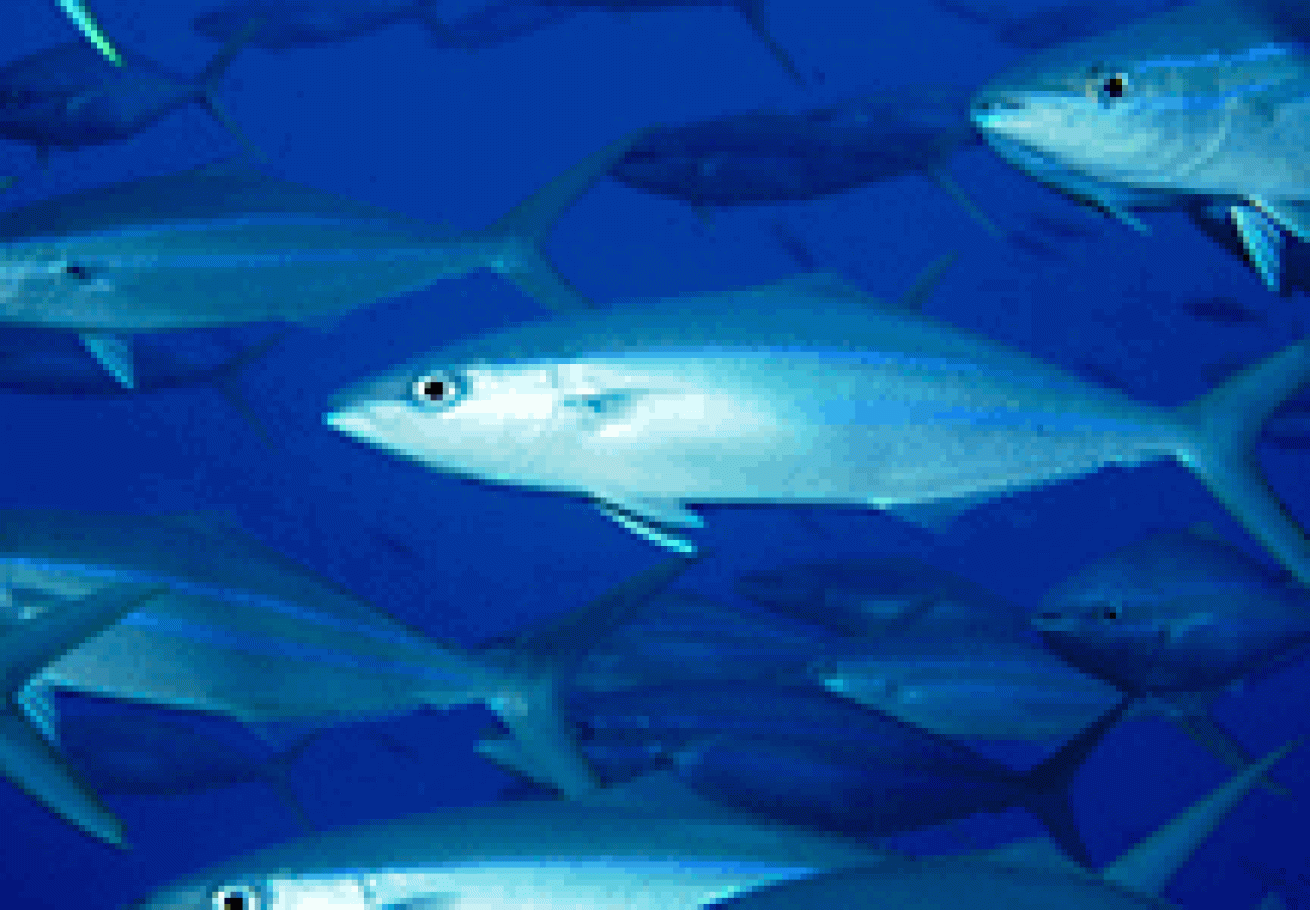
Date: Saturday, June 22, 2002
Location: New Hanover Island, Papua New Guinea
The Paradise Sport was moved this morning to the northern side of New Hanover Island, to a reef called "Big Fish Reef". It was here that we spent the morning diving. "Big Fish Reef" is a large coral bommie beginning in approximately 40 feet of water and gently sloping to a sand bottom in over 130 feet. The reef is covered with hard corals, predominantly staghorn and lettuce corals, and there are large orange sponges near the sand at a depth of approximately 100 feet. The site is known for its large fish populations including Batfish, Barracuda, Silver Trevally, Ocean Triggerfish, Spanish mackerel and occasionally, Sharks.
The first dive took place early in the morning, at 7:00am. We dove off the inflatables here, dropping to the edge of the reef facing the current and drifting back to the Paradise Sport. Immediately upon descending, the Ocean Triggerfish were evident around the edge of the reef. A total of around 50 Batfish, a saucer-shaped silver, black and yellow fish, were present. They seemed curious and followed the divers in small groups. A school of Silver Trevally passed, followed by a school of large Spanish Mackerels, over 4 feet in length. Barracuda hovered in the water column.
The top of the reef was populated by many Snapper, Regal, Blue Girdled and Emperor Angelfish, Fusiliers and other tropical fish. Clouds of Fusiliers and Damselfish completed the picture, while a small Hawksbill Turtle enjoyed breakfast, munching on the coral growth beneath the boat. As I surfaced from the dive, Hanna and Alexa Frink were playing in their raft that was tied behind the Paradise Sport. Gratefully the kids are finding plenty to occupy themselves while we dive and photograph, thanks to the friendly crew aboard.Following breakfast, I did another dive at "Big Fish Reef". Hanna and Alexa joined us on the inflatable, and snorkeled while the adults dived. The dive was much like the early dive, with the Batfish, Spanish mackerel and Barracuda making appearances, along with a Crocodilefish resting on the bottom beneath the Paradise Sport.
The next dive was at a spot named "Silvertip", better known as "Valerie's Reef". I've long looked forward to diving this site and photographing its resident Silvertip Sharks. But yesterday, during the dive briefing, we were told that most of the Sharks were gone--the victims of shark finners.
I entered the water from the swim platform on the Paradise Sport and swam under the boat toward the reef. As I did, a large Silvertip approached. It made a couple of close passes, but not enough for a photograph. I slowed my breathing and dropped close to the reef, attempting to conceal myself from the cruising shark. As I did, several other divers approached. The shark made one more pass and then swam off into the distance. My hunt for the shark continued for the remainder of the dive. I spotted it once more, but it cruised by without approaching. One of the world's great pelagic encounters now gone, all due to greed and an insatiable appetite for shark fin soup.
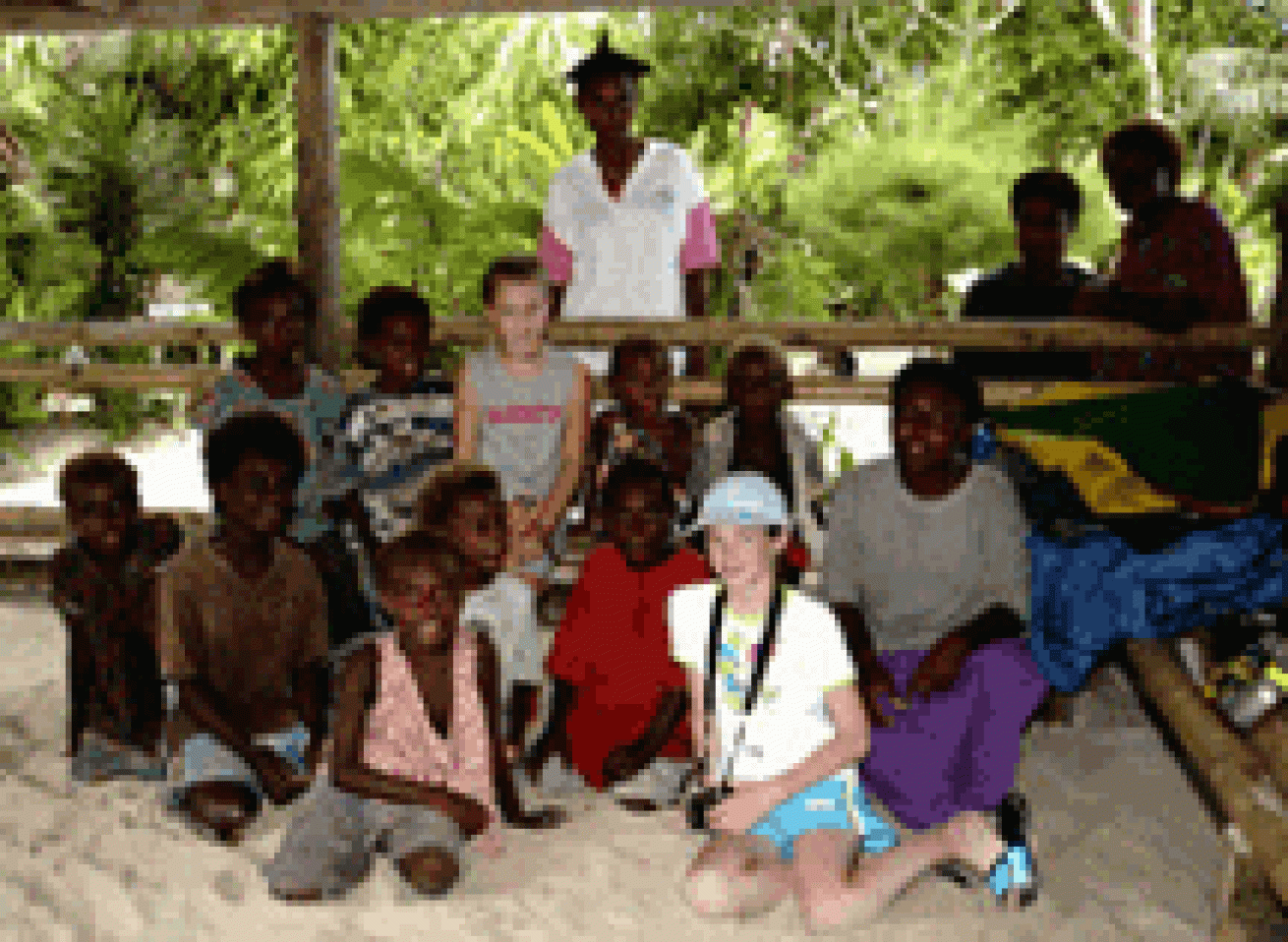
Date: Sunday, June 23, 2002
Location: New Hanover Island, Papua New Guinea
We begin this day with another dive at "Big Fish Reef", but the stunning visibility we had yesterday morning is somewhat diminished with the outgoing tide. Still, the batfish remained friendly and the resident crocodilefish entertained the critter-shooters aboard. The highlight of the morning however was not underwater at all, but rather the tour we enjoyed at Mansava Village on Losi Island.
Mansava is a fairly sophisticated village compared to other villages I've visited in PNG, with a ten room "guest house" for visitors, electricity and schooling through grade 8 for the children. Nevertheless, the tour was an excellent cultural experience for us all, but especially the children, Hanna and Alexa. Hanna was curious about why so many of the villagers had red teeth, and wanted to know all about betel nut. The concept of outriggers on a canoe intrigued her, and as a kid-to-kid goodwill ambassador she shared her candy with the local children. The photos we took of the kids with the villagers may prove to be our most significant of the day, at least in our memories.

In the afternoon, we cruised to Three Islands Harbor, off of Dunung Island on the northwest side of New Hanover. Our objective there was to dive a wrecked World War II Japanese freighter, the "Taisho Maru" and mini-submarine. The 300 foot "Taisho Maru" was sunk by and American B-25 bomber from the 500th squadron on February 16, 1944, and now rests on her starboard side in 70 feet of water, but her port rail comes to within 15 feet of the surface.
We spent the remainder of the day diving on the "Taisho Maru". While the visibility around the wreck is limited to 25 feet max, this is a sensational dive both for the resident marine life and encrusting filter feeders. The wreck itself is a mind-blowing array of colors from a profusion of soft corals, sea fans, sea whips, whip coral and hard corals. Above the wreck there are huge schools of fish--Silver Trevally, Snapper and Chub. The sea fans and soft coral growing on the wreck provide habitat for small gobies, hawkfish, butterflyfish, angelfish, wrasse and damselfish, while the sand around the wreck has a large population of stingrays, gobies and their partner shrimp and numerous pairs of Crab-Eyed Gobies. Many species of nudibranch inhabit the wreck and surrounding environs. While a night dive on the wreck is offered, and is no doubt awesome, we opt to conserve bottom time for a big day tomorrow at Chapman's Reef, one of the icons of the Kavieng itinerary.
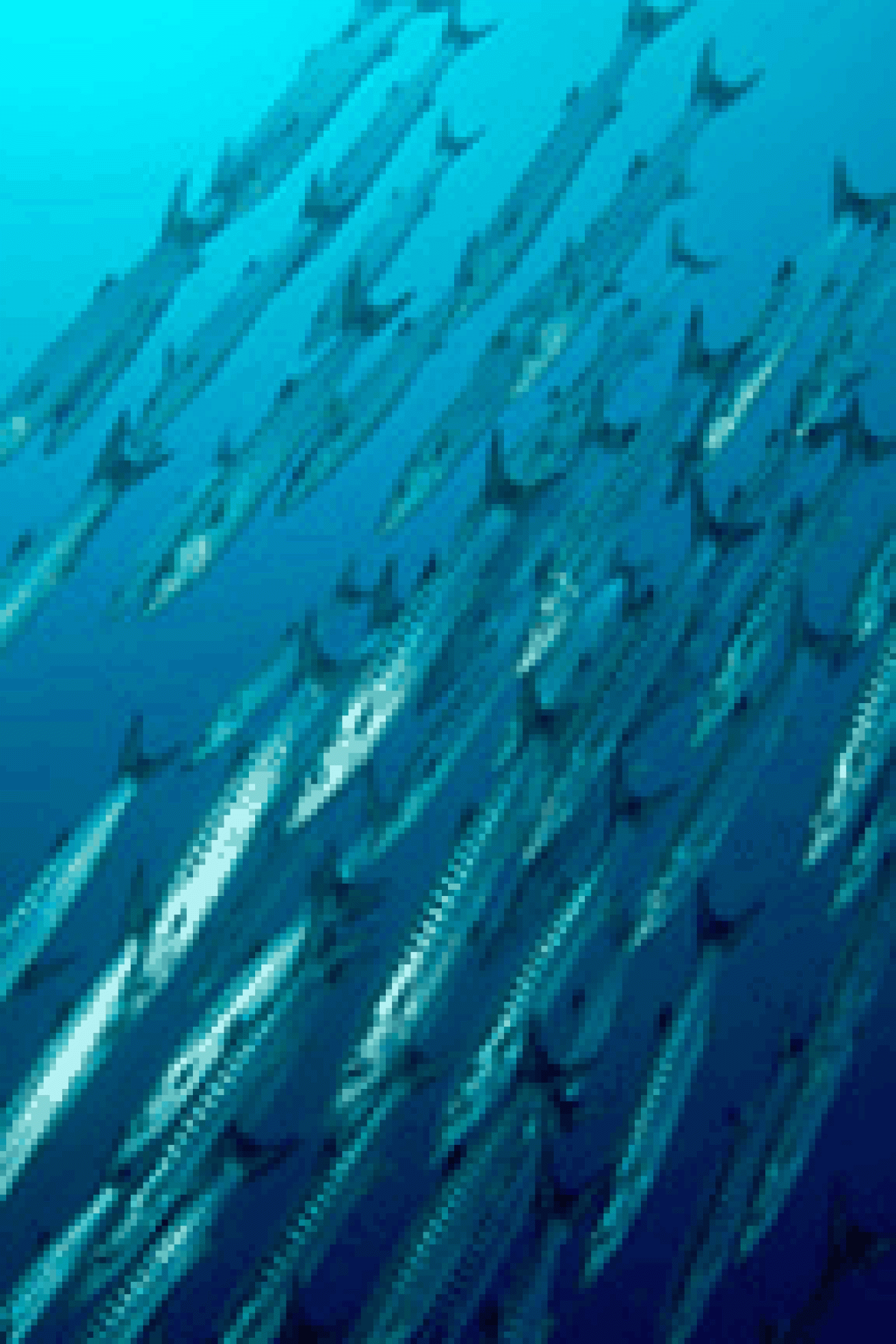
Date: Monday, June 24, 2002
Location: New Hanover Island, Papua New Guinea
Dive Day 3 - Chapman's Reef - Located along the eastern tip of New Hanover Island, Chapman's Reef is their premium pelagic rendezvous, when the current is running anyway. Like Blue Corner in Palau, current bring the sharks to the reef. Without current, like we had this day, there were still schools of barracuda, but not the school of several thousand barracuda likely when the current is strong. We were all given reef hooks and it was suggested we hook into a dead bit of reef and watch the show go by. In the absence of the current we can swim about, and we find some very nice soft corals and large sea fans in the 60 to 100 foot range. There are schools of batfish here, as well as soldierfish, pufferfish, filefish, angelfish, butterflyfish, anthias, clownfish, Titan triggers, and even the normally reclusive clown trigger posed nicely this day. The cleaning station activity and generally frenetic fish life makes this a great dive, whether at depth for soft corals and pelagics or in the shallows for the reef creatures. We stay tied up to the mooring all day here, and most do 4 dives during the day, and since the current is so minimal, it is available to us as a night dive as well.
Much of the diving we have been doing is fairly deep, maybe 115 - 120 for a maximum depth, and then working up the face of a bommie to about 40 feet. Even diving a safe, multi-level profile loads plenty of nitrogen by the end of the day. Gratefully the Paradise Sport has a membrane Nitrox system, and by diving Nitrox 32% on air tables, we increase our safety margin. This far from help and recompression, it is best to err on the side of caution.
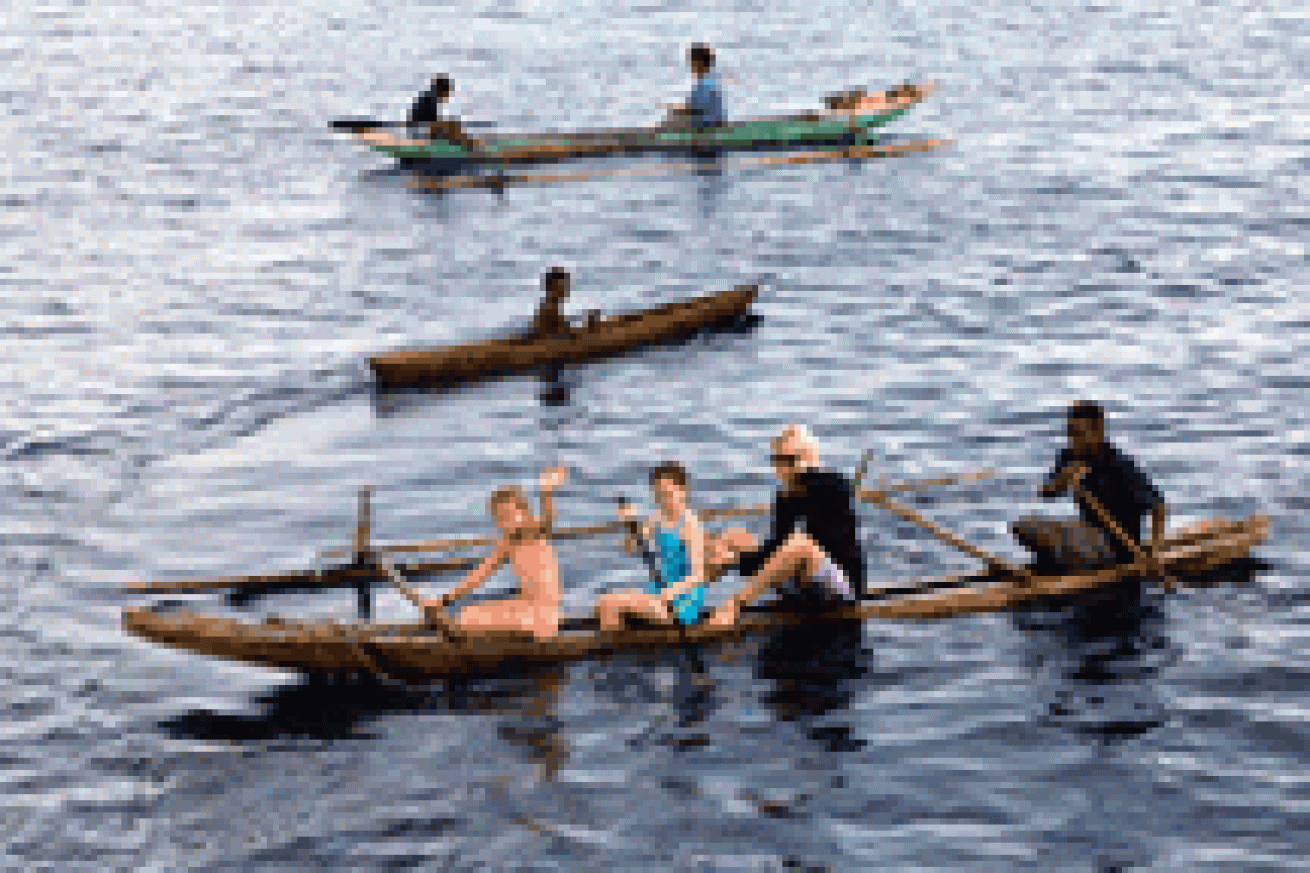
Big day for the kids today too. Even though it is a bit too deep for them to snorkel, they are well entertained when the local villagers come by in their dug-out armada. Alexa and Hanna are invited to go on a canoe ride around the boat. . .surely a more exciting "What I did on my summer vacation" story than most of their buddies.
We are thoroughly enjoying the Paradise Sport and her crew. We have 21 passengers on board this week, and it might seem at first that this is a big group, but the boat is so spacious, and the dive deck so well organized, we never feel rushed or crowded. The following is some general information about the boat gleaned from the Mike Ball web site (www.mikeball.com):
KAVIENG EXPEDITIONS ITINERARY (May - August) - #P6 10 nights/9.5 dive days
Kavieng is the pelagic capital of Papua New Guinea with a worldwide reputation as one of the premiere places to observe pelagics in the wild. A typical cruise covers New Ireland's North Cape, East Islands and a circumnavigation of New Hanover Island. This includes the archipelago region lying between New Hanover and New Ireland embracing Enang, Selapiu and Baudisson Islands. Cruises may also include Tingwon Island to the South West of New Hanover. Divers should expect some current on dives conducive to pelagic action.
Paradise Sport will be moored at your first dive site soon after you have unpacked your dive bag. Just a five minute drive from Kavieng's airport you board Paradise Sport at Kavieng's beautiful palm fringed harbor. Many islands are nearby with perfect white sand beaches sheltering coral gardens, which abound with exotic marine life.
First Dive Day - Includes an afternoon dive plus a night dive
Pelagic Animals - Huge schools of big eye trevally and barracuda ball up while Spanish mackerel, dogtooth tuna and Eagle rays cruise the reef edges. Gray reef, White, Silver and Black tip sharks glide through the blue backdrop of both the Bismarck Sea and the Pacific Ocean.
Wall Dives - There are many wall dives possible. The most famous being Chapman's Reef, a natural amphitheater where huge schools of fish gather to feed in the strong current. An amazing pelagic spectacle.
Pass Dives - The narrow passes leading into the lagoon between New Hanover and New Ireland provide exciting dives on reefs smothered by soft corals and gorgonians. Countless species of fish amass near the reef edge from Sand gobies to Eagle rays. A variety of dives are made at these passes pending the current throughout the day.
Nautilus Dives - Nautilus are captured from deep water. Divers can photograph them as they are released in shallow water before being returned, unharmed, to their deep-water home.
World War II Wrecks - Nakajima Kate, an aeroplane in superb condition, a large freighter and a 2-man mini-submarine are included. Abundant marine life adorn these wrecks allowing wonderful photographic opportunities for non-wreck fanatics.
Ecucha Patch - Here lays the wreck of the scuttled Der Yang, a fishing vessel perfectly positioned for wide-angle photography surrounded by schools of big eye trevally and barracuda.
Shark Dives - Watch these animals predating, mating, being cleaned or simply hanging motionless in the current. Our best shark action occurs at Albatross Channel, Chamisso Channel, Eagle Ray Pass, Valerie's Reef and Chapman's Reef.
Cultural Experiences - Visit the unspoiled paradise of Mansava village on Tsoi Island, enjoying the local hospitality.
Last Dive Day - Includes two morning dives before returning to port.
Final Evening - P6 expeditions final evening will be aboard Paradise Sport.
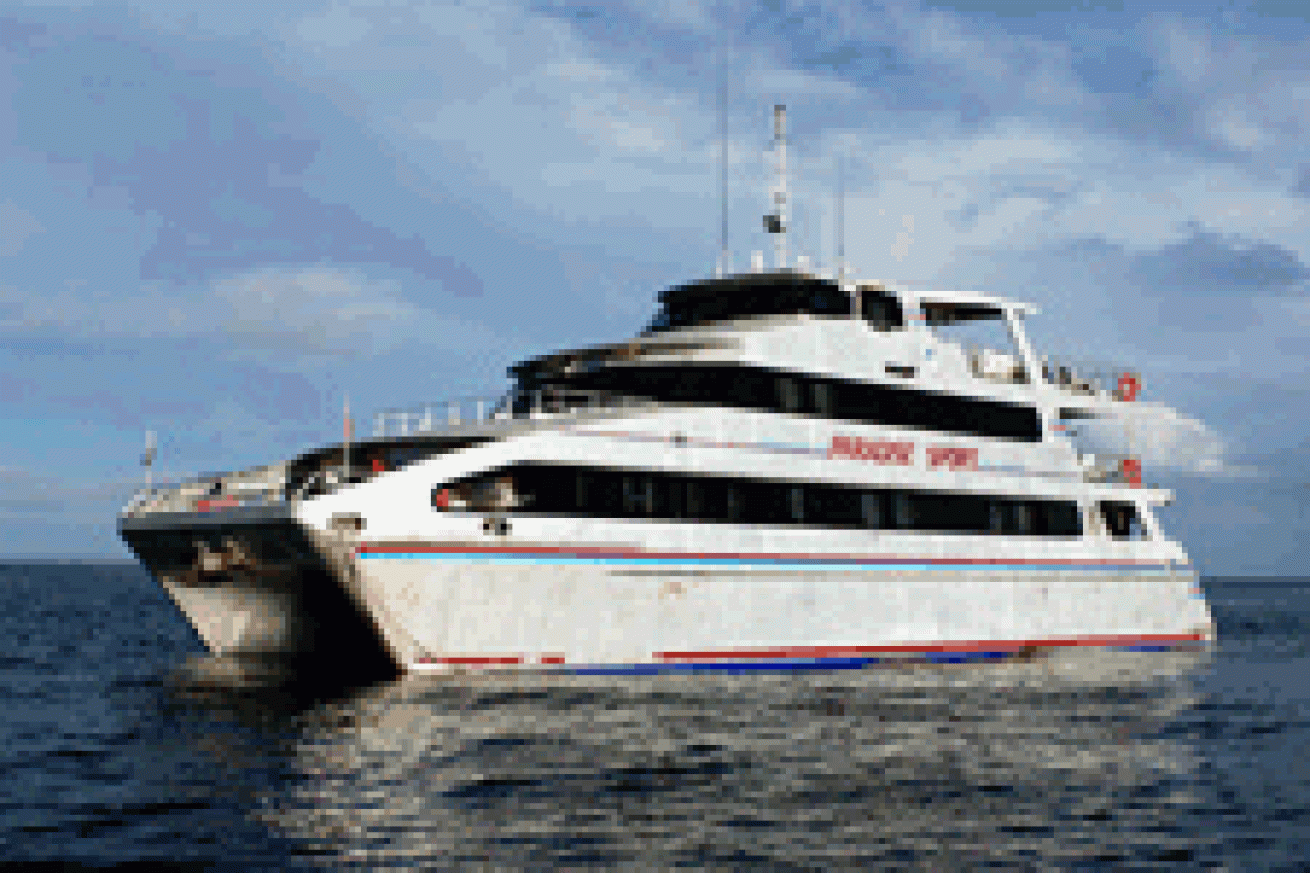
VESSEL INFORMATION:
Paradise Sport (5 Star), Guest Accommodations by cabin type:
Premium (170 sq. ft), King bed + single, TV, VCR, Desk, Marine reference library
Large private bath, Ocean view
Standard (120 sq. ft), King bed or twin beds, Private bath, Ocean view
Economy (72 sq. ft), Twin bunk beds, Connecting bath, Ocean view
Budget (very small), Twin bunk beds, Connecting bath
Length - 30m (100ft); Beam - 10m (32ft); Speed 16 knots; passengers maximum 22
Amenities - Appreciate the spectacular scenery from the unique forward observation deck. Twin hull design for more space, comfort and stability
Choose the dedicated dining room or alfresco deck for sumptuous dining
Relax in the spacious lounge or on the shaded or open sun deck
Very comfortable twin or double accommodation with individual air conditioner controls. Enjoy your choice of hot drinks with our early morning wake up call
Complimentary soft drinks and Australian wines (with dinner)
Unlimited diving - reef, wreck, night, shark, nautilus & deep dives
Non divers welcome - spectacular scenery & cultural experiences
Unlimited fresh towels after every dive
Maximum 12 divers at small sites, choose between main vessel or tender dives
Exotic creature finding service - we find them, you shoot them
Complimentary Reef Ecology Certificate course
Mike Ball Dive Expeditions Safe Scuba System ensures both experienced and novices are catered to.
Solo diving as per Mike Ball Dive Expeditions Safe Solo Program
Photo and video pro on board.
Huge dive deck with multilevel camera station
Nitrox (EANx32) fills $10, daily $25, nitrox instruction available

Date: Tuesday, June 25, 2002
Location: New Hanover Island, Papua New Guinea
We got a late start this morning, cruising to Tingwon Island to the southwest of New Hanover Island. This is a little visited area, dived only a few times a year on the Paradise Sport's longer itineraries. It takes calm seas and a 10-day itinerary to make it this far, so with high anticipation we back-rolled off our dinghy for our morning adventure at "Dragon Point". We expected clear water, great soft corals, and good pelagic action. However, we got none of the above.
The weather continued to be overcast and rainy, but additionally, during the night, significant swells built, creating fairly uncomfortable surge conditions underwater. The visibility was poor, but that was OK because there wasn't much to see anyway. The wall dropped vertically from about 25 feet to apparently 3,000 feet, but the turbid water prevented the pleasant vertigo we dive walls to experience. There were large barrel and elephant ear sponges, some sea fans and large plate corals; but little in the way of colorful soft corals. I spotted a single Grey Reef Shark, a lone Hawksbill Turtle, a Spanish Mackerel and a Queensland Grouper. There was a school of Batfish cruising along the wall in the distance, and good congregates of Surgeonfish and Rainbow Runners. But all in all, it was a disappointing dive. Steve and I gave each other the universal "gag-me" sign underwater and hoped for a better second dive.

Upon returning to the Paradise Sport, we found our sentiment was universal among this group of dedicated underwater photographers, and we bade good-bye to Tingwon Island to return to Chapman's Reef. The two dives here were MUCH improved over our exploratory dive earlier. During the first dive, I went to observe and photograph the Decorated Dartfish, the Long-nosed Hawkfish living in the yellow soft coral, and a few anemones with Anemonefish and Eggshell Shrimp.
One of the nice things about enjoying multiple dives on the same site is that we learn where the best set-ups are. On a previous dive I had seen a lovely yellow soft coral tree, and while my preference for macro was evident as I captured a long-nosed hawkfish amid the polyps, Stephen's wide angle vision included the same soft coral tree with his wife Barbara modeling in the background.
The last dive was the most impressive at Chapman's Reef. Shortly after entering the water there were several hundred schooling Barracuda swimming in a graceful ribbon of silver, looping around and up before plunging into the abyss along the edge of the reef. Other Usual Suspects included a large Dogtooth Tuna, a school of Rainbow Runner, a couple of large Queensland Grouper, an Emperor Wrasse and the omnipresent Batfish. The sheer energy on the reef this late afternoon was electric and inspiring.
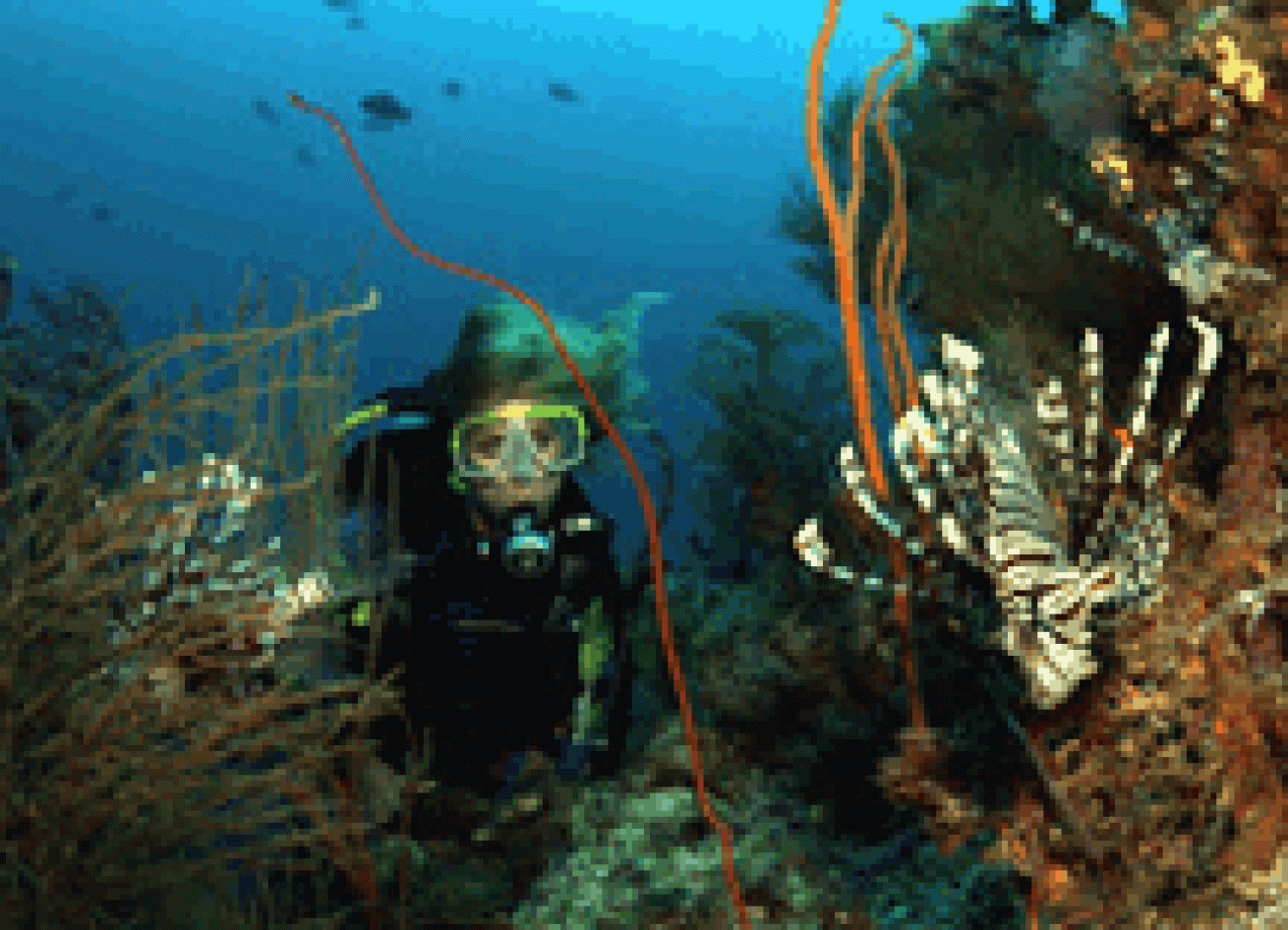
Date: Wednesday, June 26, 2002
Location: New Hanover Island, Papua New Guinea
For much of today, we dived at Chamisso Channel, between two small islands to the southeast of New Hanover Island. The geography funnels massive amounts of water through the channel at the tidal shift, and the dive concept is drop down at the edge of the wall, hold on with reef hooks when necessary, and watch the marine life and filter feeders that abound along the mouth of the channel. Aside from the gorgeous color and texture of the sponge and soft corals, the big appeal is pelagic action.
Chamisso gratefully lived up to the advance billing! Among the pelagic attractions were Grey Whaler Sharks, a large school of Trevally, a small school of Barracuda and the ubiquitous Batfish. The backgrounds were exceptional as well, with a vertical drop-off adorned with Sea Fans, Soft Corals and large sponges. There was a multitude of Volitans Lionfish and outstanding reef minutia such as Garden Eels, dozens of Fire, Decorated and Twotone Dartfish, and gobies and their partner shrimp. I did three dives at Chamisso today, all with a maximum depth around 100 feet, the depth just below the mouth of the channel. Nitrox to the rescue one more time!
Between dives, Hanna and I joined Steve and Alexa Frink for a long snorkel on the coral reef in the channel. The reef was beautiful, with a healthy covering of hard coral. There were many anemones and anemonefish, including one woven among the branches of a large area of Staghorn Coral. That anemone must have covered an area nearly 100 square feet and was home for a dozen or more Tomato Anemonefish. We also watched a small Orange Spotted Filefish hovering near the branches of the coral.
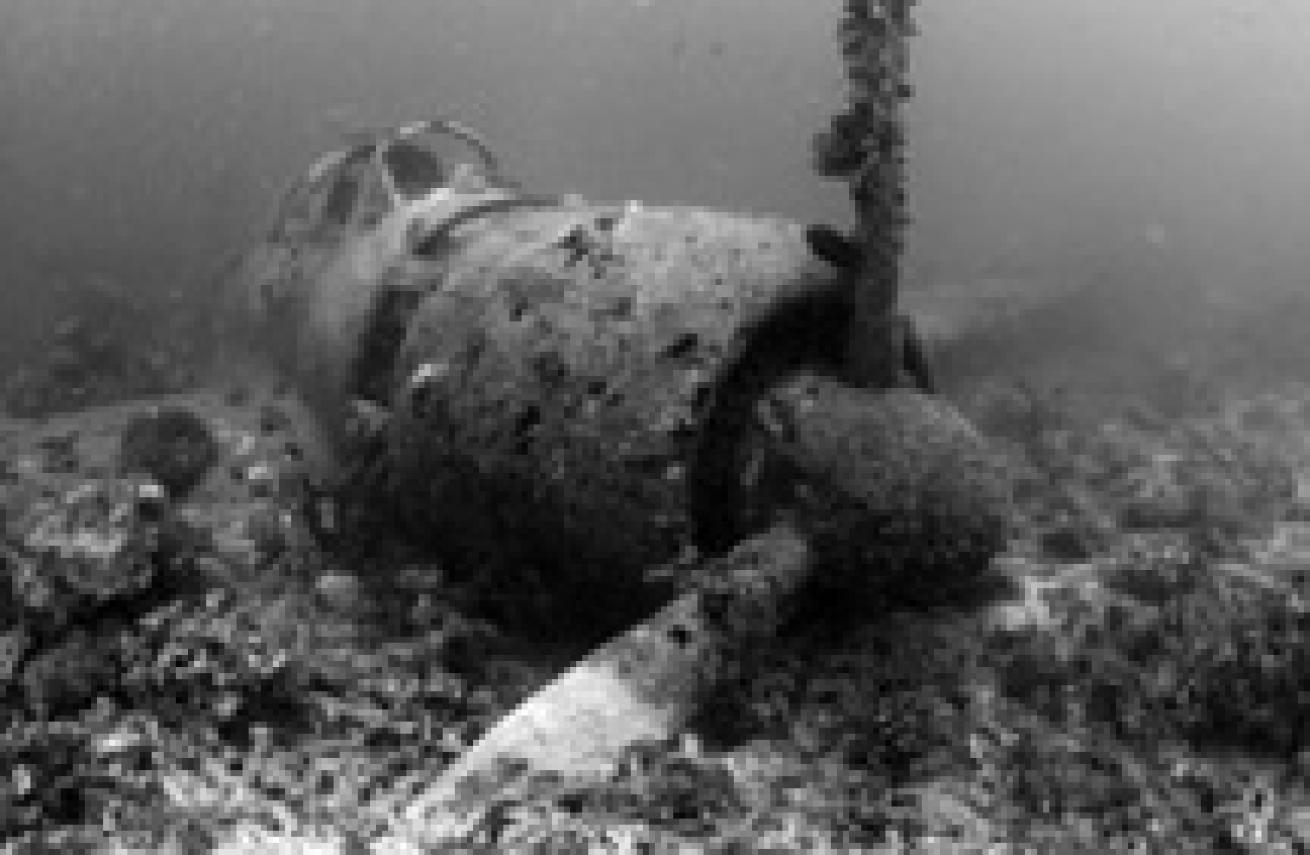
We left Chamisso Channel in the early afternoon to move a short distance to the site of the Nakajima Kate, a Japanese Zero sunk during World War II. In spite of the historical significance of the plane, I chose to stay on the Paradise Sport to continue to offgas. Steve did the dive however, and was able to come home with an interesting series of photos in spite of the marginal visibility at this site. With this time between dives, I was ready for a long night dive at Nusandaula Reef, said to be the finest after-hours dive in the area.
While the reef was not particularly lush, the creatures were compelling. A pair of stonefish seemed to be everyone's favorite this night, and of course there were the normal subjects like lionfish, clownfish, and many species of butterflyfish that were too skittish to shoot during the day, but easy at night.
Following the night dive and dinner, we were joined by people from a nearby village for a sing-a-long. The villagers sang a number of hymns reflecting the missionary influences of these islands, while we reciprocated with vintage rock and roll, reflecting a different influence all together. Steve led a version of "Do Wah Diddy-Diddy" and I led the group in a rousing "Joy to the World". Needless to say, the villagers sang much better than the divers, but everyone had a good time and a lot of laughs!
Date: Thursday, June 27, 2002
Location: New Hanover Island, Papua New Guinea
We began our day today at Nautilus Bay--so named for the Chambered Nautilus that live in the deep water, 3000 feet and more, beyond the drop-off. It is here that the crew of the Paradise Sport set traps to collect Nautilus, permit the divers to observe the Nautilus on scuba, and then carefully release the animals, unharmed, to the deep water from where they were taken.
We entered the water and spent about 15 minutes per group observing and photographing the Nautilus. The crew suggested Nautilus protocols that included minimal strobe and video light intrusion to avoid unduly stressing the animals. While the Nautilus interaction was the highlight of the dive, the rest of the time spent in the pristine shallow coral garden was inspirational as well. Much of the reef consisted of high profile hard corals surrounded by sand channels, with reef residents much like we have been experiencing on other Kavieng reefs.
Following our dive at Nautilus Bay, we moved to Planet Channel, adjacent to Chamisso Channel, where we spent most of the day. The dive plan at Planet Channel was essentially a replication of yesterday's routine at Chamisso--enter the water at the mouth of the channel, observe the lush invertebrate growth and pelagics along the drop-off, then drift with the current while offgassing to end the dive.
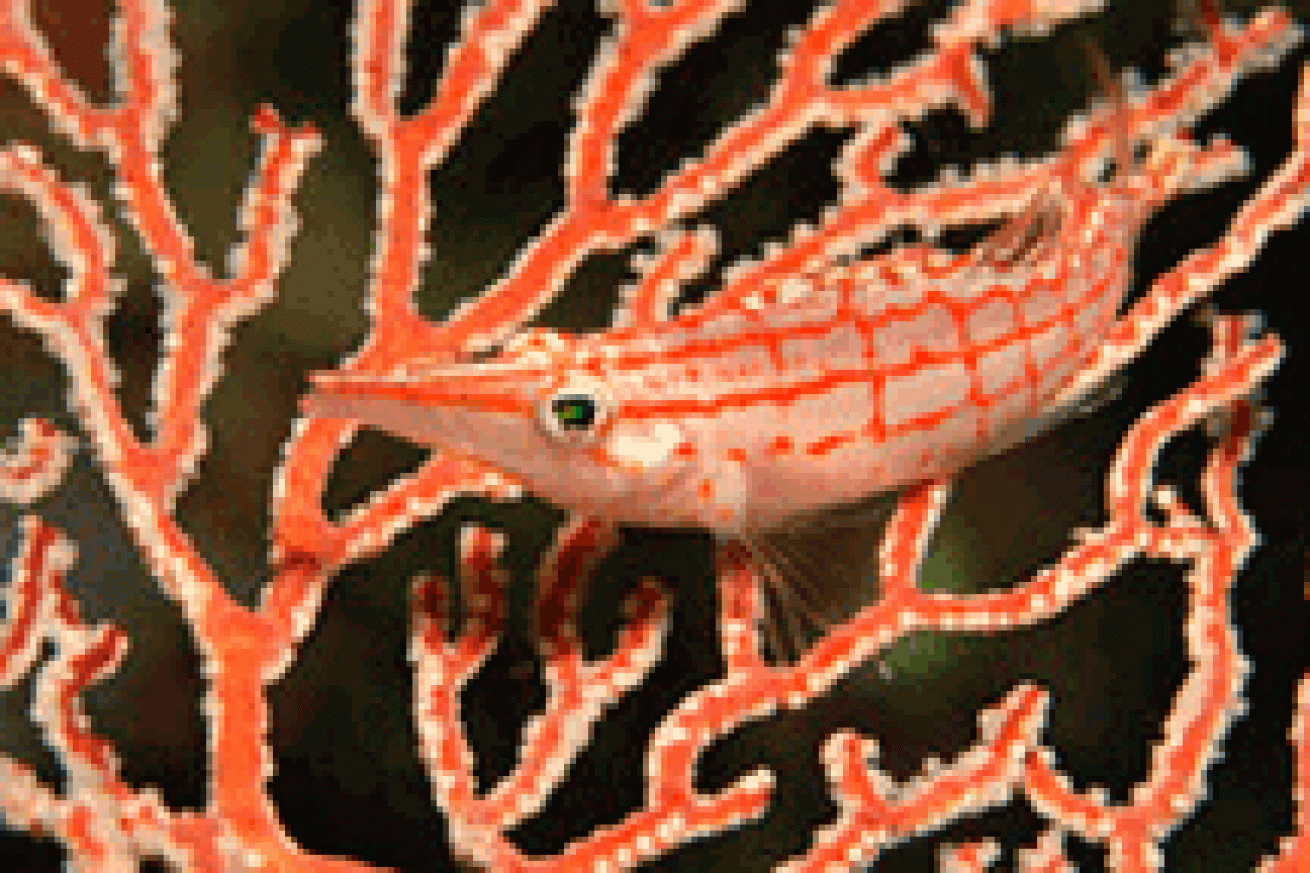
Upon entering the water, I was greeted by a huge school of Silver Trevally. I swam with the Trevally until they led me to deep water, where we parted as I turned to the reef wall in pursuit smaller critters and less nitrogen loading. The wall was adorned with large Sea Fans, red Sea Whips and Soft Coral Trees, many of which were inhabited by Longnosed Hawkfish. Congregating along the wall were large schools of Snapper. I stopped to photograph the Snapper, but the nearby school of Barracuda hovering above continually disrupted my concentration. Snapper to the left, barracuda to the right. What to shoot? A good dilemma to have for sure!
When I looked back at the Barracuda, I spotted three Grey Whalers Sharks cruising past along the edge of the dropoff. One of the sharks repeatedly approached me, but since he was relatively small (only 4 to 5 feet long), I needed him 3 feet away to fill the frame on my 17-35mm zoom. As if to exasperate me, this shark seemed to find 5 feet his magic zone of comfort, making underwater imaging difficult. Fortunately, since I am recording the scene on my Nikon D1X digital, there is always the possibility of doing a black and white conversion if the graphic shape is strong enough. I watched the shark until my computer strongly suggested it was time to ascend, at which time I swam up and over the reef and began to drift through the channel in the current to end the dive.
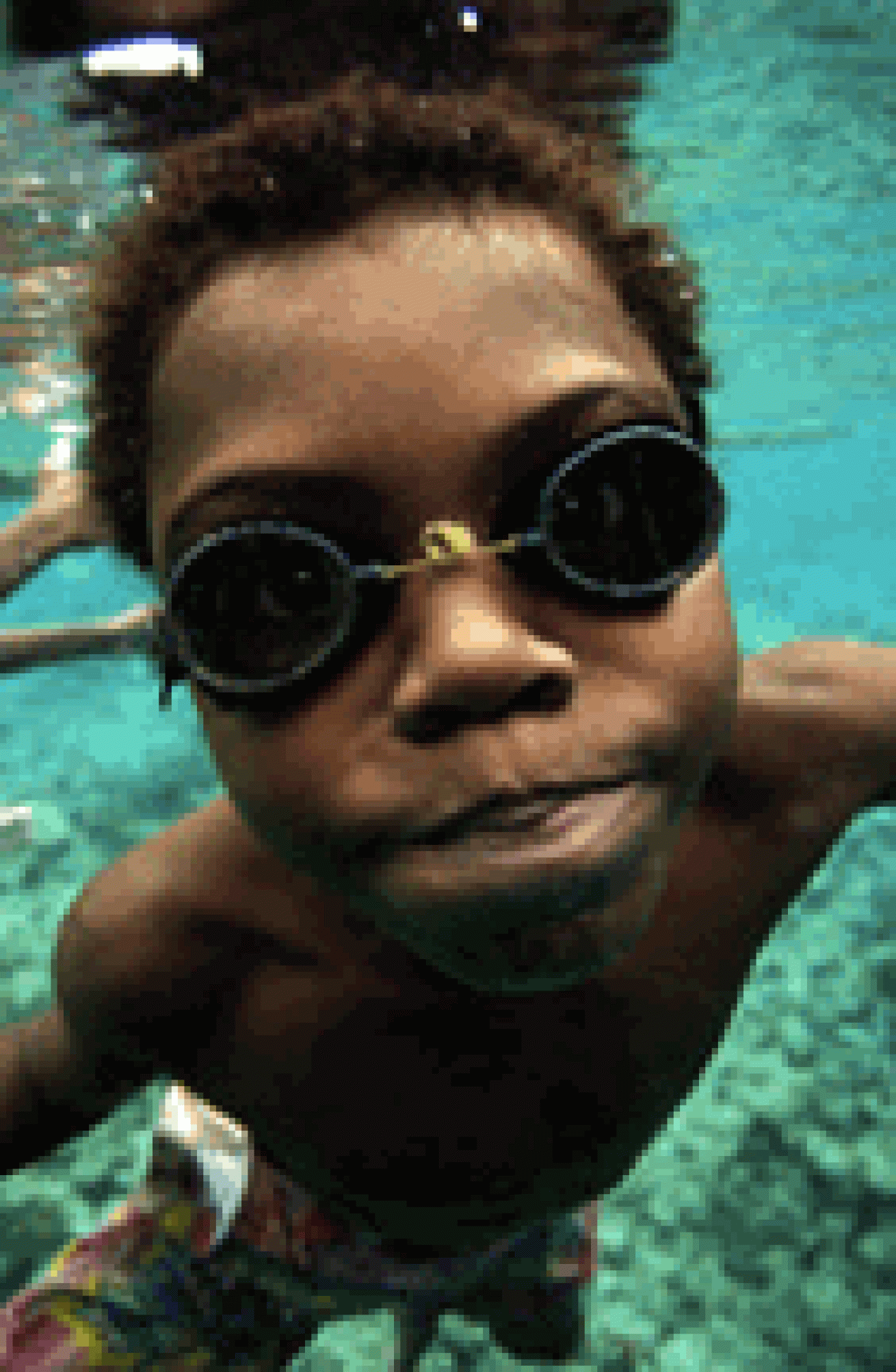
I drifted a long distance from the Paradise Sport during the long safety stop necessary to safely offgas from my deep dive. It began raining while I was underwater, and I wasn't sure the crew of the Paradise Sport would be able to see me. I deployed my Safety Sausage and blew my Dive Alert. Quickly, a young local boy in his outrigger canoe came to keep me company while I waited for the inflatable. I didn't see how I was going to fit me, my tank, and my cameras aboard the outrigger, so I was well pleased indeed when the inflatable arrived.
This is probably a good time to offer a brief thank you to the dive crew and dinghy operators aboard Paradise Sport. The operation is absolutely top notch. Friendly, professional, efficient; and truthfully this vessel has some of the best dive ergonomics of any live-aboard I've dived from. Little things like the shower rooms on the dive deck, and big things like the Nitrox membrane system consistently delivering our 32% mix makes it easy to dive 5 dives a day and shoot LOTS of film and pixels.
Hoping for more/better Grey Whalers, I went back to the same spot at Planet Channel. The Trevally were present, as were the Barracuda and Snapper, but only a few Grey Whalers cruised past. I thought about attempting to approach the sharks, but their depth and speed made such an effort impractical. The whole shark interaction is very tide dependent, and the crew pays special attention to time the dives for optimal current flow. Assuming that's what the group is looking for of course. For those who prefer more placid dives, there are plenty of options with minimal currents.
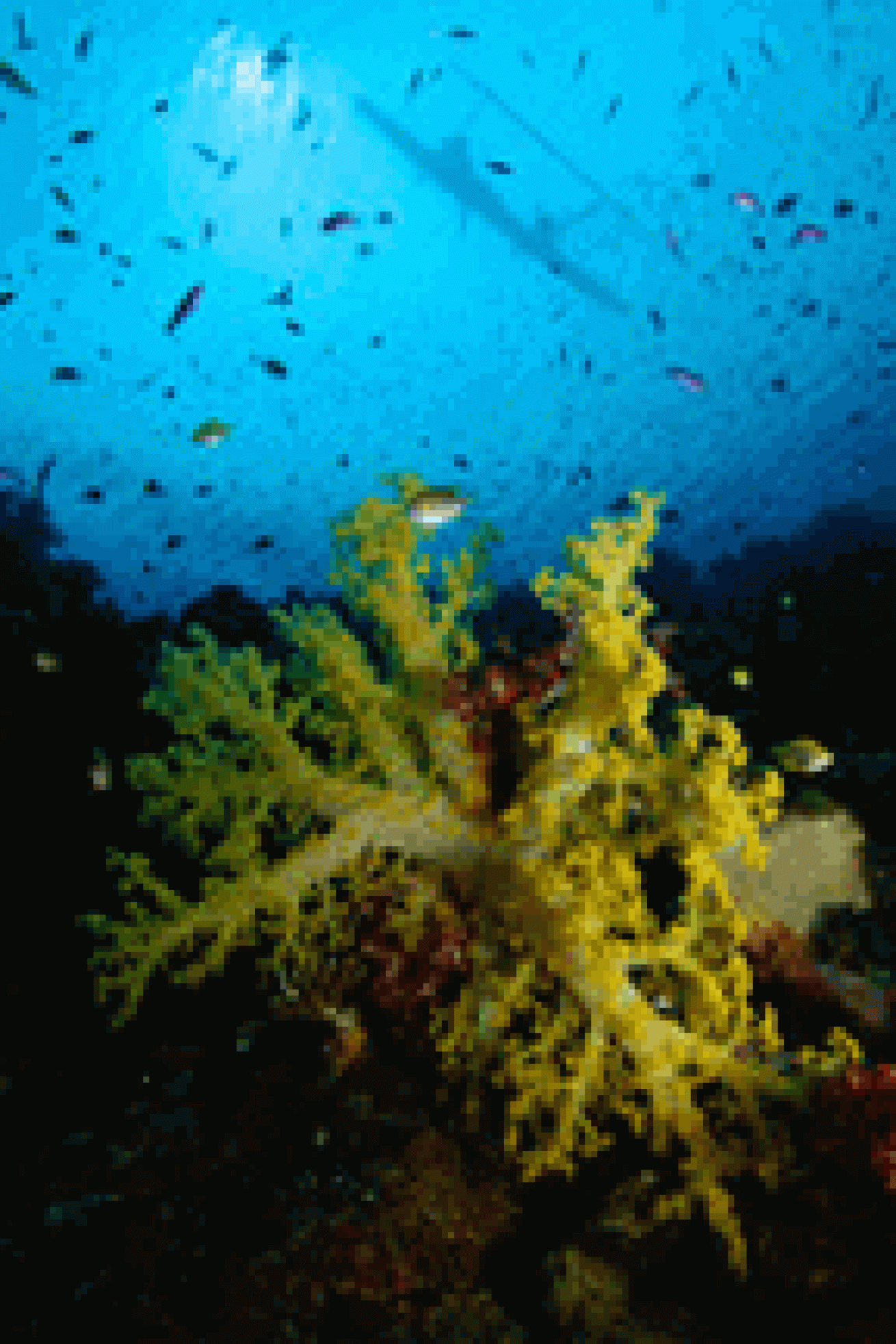
I continued along the wall, stopping to observe and photograph the beautiful Sea Fans and Soft Corals along the way. As I slowly made my way up the reef to shallower water, I notice that a couple of local boys in an outrigger canoe were following and watching me from the surface. I took the opportunity to photograph the canoe on the surface with a yellow Soft Coral Tree in the foreground.
Following the dive, Hanna and Alexa Frink asked to go snorkeling, so we took the inflatable to the edge of the wall. There we observed a white-tip Reef Shark and a Black Tip Shark, a school of Bump Head Wrasse, a Red Volitans Lionfish and many different species of anemonefish.Apparently Steve had taken Lexy and Hanna snorkeling at the same spot earlier, but had even more interaction from the local children. The PNG children were almost frenetic in their curiosity about the girls, which I guess makes sense considering how infrequently kids join the Kavieng itinerary aboard the Mike Ball boats. However, from our point of view this is a great life experience for the kids. One that not only introduces cultural diversity, but shows them some of the wild unspoiled coral reefs still remaining on our planet.
At night, after another exciting night dive at Nusanduala Reef, we connected the satellite phone to my laptop computer to send our most recent update to www.scubadiving.com. While the satellite phone provides us with the ability to communicate from a distant corner of the globe, it comes with some difficult workflow issues. The phone doesn't permit the use of my normal e-mail software and the functionality offered by the ISP is limited. Most significantly, the transmission of data is slow, making the submission of photos particularly troublesome. But we will persevere nevertheless, bringing our diving adventure to the many avid divers on our online community.

Date: Friday, June 28, 2002
Location: New Hanover Island, Papua New Guinea
We were moored this morning at Judy's Reef, to the southeast of New Hanover Island, adjacent to Planet Channel where we spent the day yesterday. Judy's Reef is a series of coral bommies that rises from the depths to as shallow as fifteen feet from the surface. Neither the bommies nor their growth of invertebrate life are very compelling, but the fish life and small critters inhabiting this reef were terribly impressive. There were schools of Rainbow Runners, Fusiliers, Triggerfish and Surgeonfish in the waters surrounding the bommie, and Anthias swarmed facing the current. Once again there were dartfish, doing just what their name suggests, darting about just fast enough to create a photographic challenge. On a couple of covered ledges at 45-50 feet, I found a couple of Randall's Sailfin Gobies and a White-Capped Goby, all cohabitating with their housekeeping partner shrimp. But the find of the day was by Caroline, one of the crew of the Paradise Sport, who spotted a minute, beautiful but deadly Blue Ringed Octopus on the top of the coral ridge near the mooring. Of course, none of us were there at the time, so we delivered no photographic proof of her discovery.
After my second dive, while we relaxed on the boat, Ruth, the Trip Director aboard the Paradise Sport returned from a nearby exploratory dive raving about the "hundreds of aggressive sharks, thousands of Barracuda and the beautiful wall". Alastair, one of our fellow guests who was diving with Ruth, said the sharks were so interested in him that he felt flight more prudent than confrontation. So, we figured if the sharks were rowdy, we should be there.
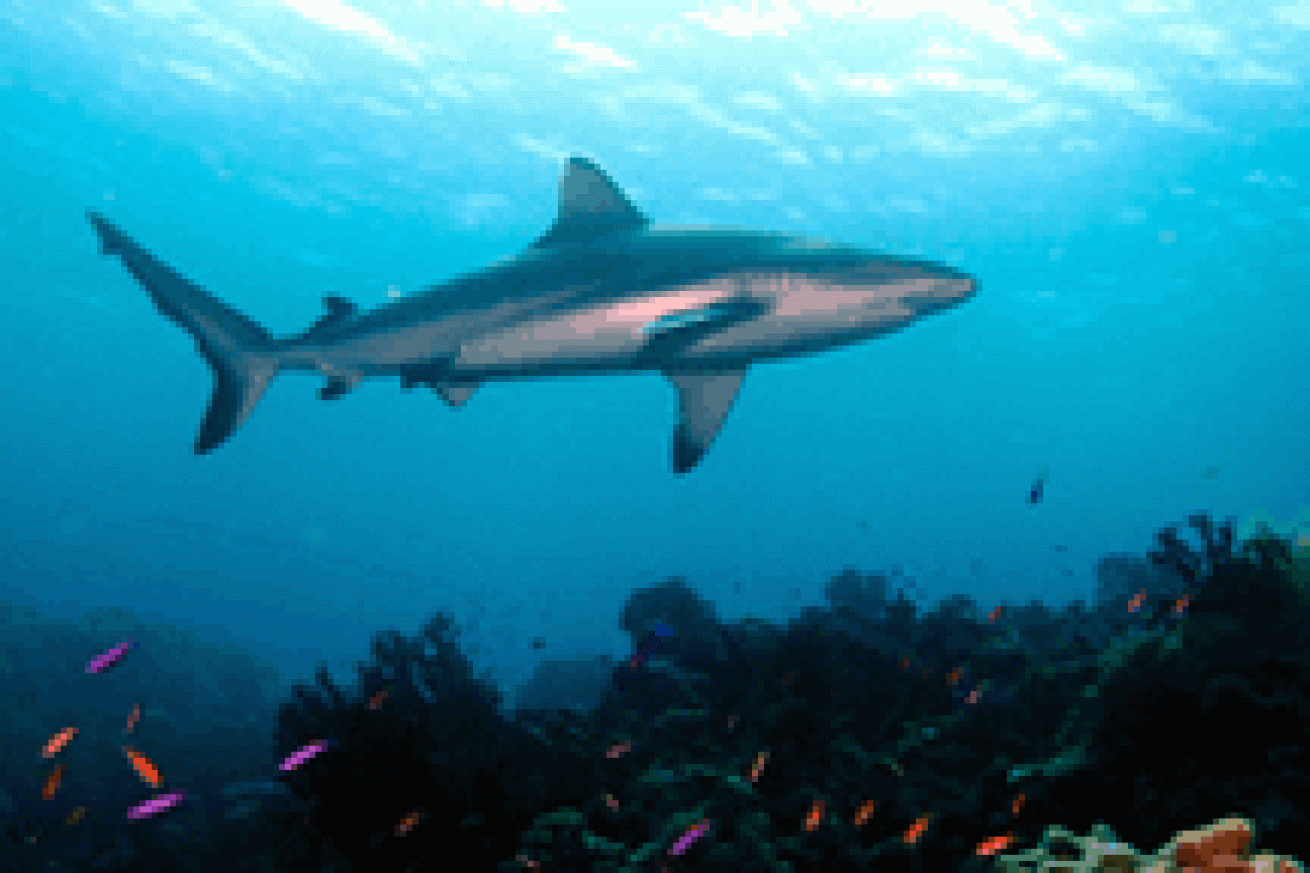
Quick as we could, a number of us suited up to join in the fun. We took the inflatable over to "Byron Strait" and back-rolled into the blue. Apparently the current had subsided considerably since Ruth and Alastair had been in the water, but there were still plenty of Gray Whaler Sharks (I counted 25-30) and the wall was incredible, with numerous crevasses and undercuts and thickly covered with large Sea Fans and red Sea Whips. As the current subsided, however, so did the aggressive behavior of the sharks, so once again, there were no significant photo-ops. Plenty of sharks but no close encounters had become predictable by now, at least for us this particular week.
In the late afternoon, Hanna and I did some snorkeling on a shallow reef near the boat. As we explored the shallow reef, the sun finally emerged, a welcome break from yet another day of overcast. While the Paradise Sport offered a night dive, as they do most evenings, I settled for an afternoon critter dive instead. I donned my scuba gear and grabbed my camera and went back in the water for a dive to the same ledge I had worked earlier. Like before, there were Randall's Sailfin and White-Capped Gobies, but while they were pretty shy before, this time they seemed more cooperative. Whether it was the late afternoon time of day or the better ambient light conditions, I don't know, but the gobies and most importantly their partner shrimp were willing to come out from the safety of their burrow, providing the opportunity for some significant underwater images.
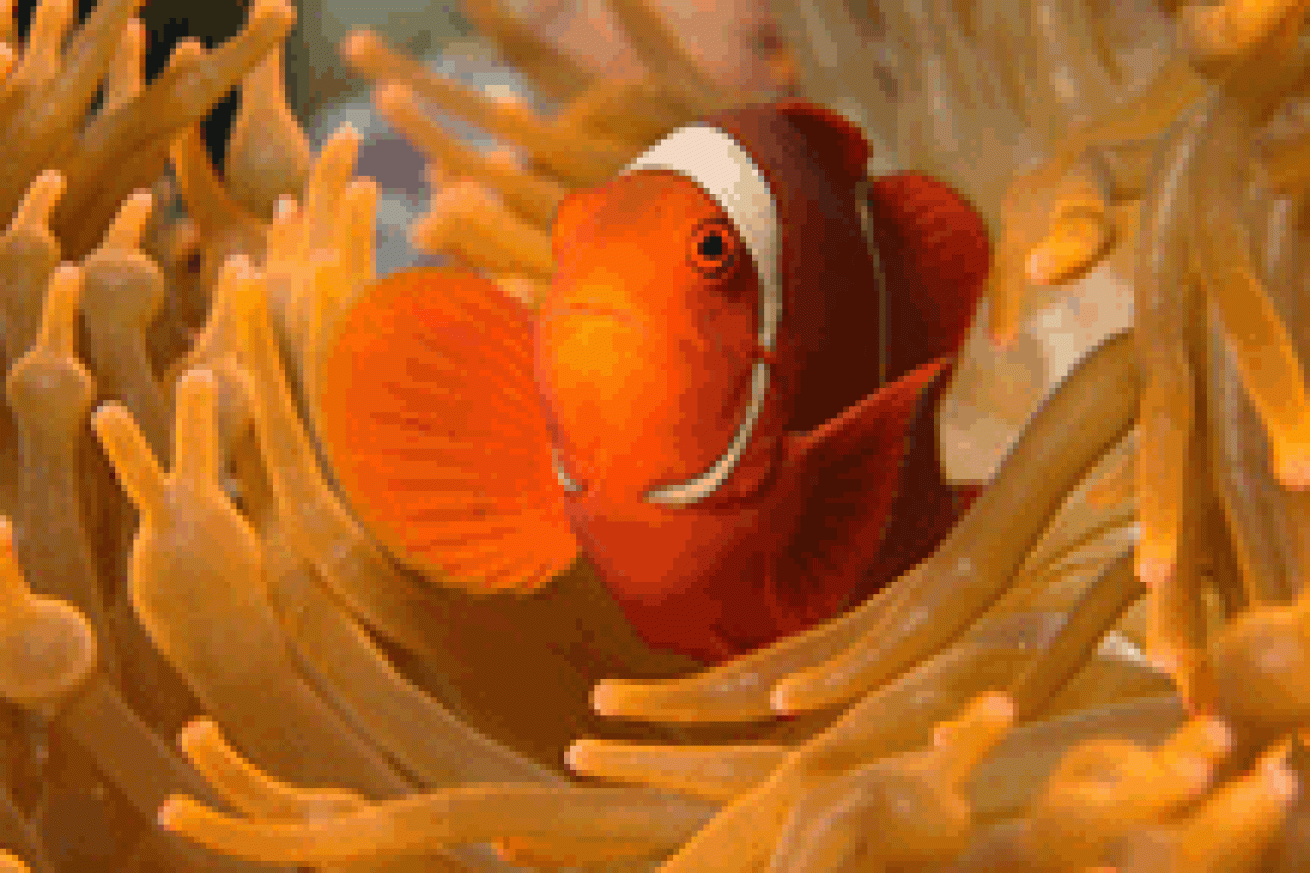
Date: Saturday, June 29, 2002
Location: New Hanover Island, Papua New Guinea
Our plan today was to dive in the early morning at a spot named "Anemone Patches" until the current gained strength at which time we would dive at nearby "Mascotte Channel".
Anemone Patches is a series of large coral bommies, gently sloping to the bottom from as shallow as ten feet beneath the surface of the water. As the name of the site suggests, the reef is covered with anemones and many species of anemonefish. I entered the water and quickly found a Hawksbill Turtle resting in the coral. I watched and photographed the turtle until it decided to move on, so I did as well. I also photographed a Spinecheek Anemonefish in a red anemone. Oddly, I've photographed this same kind of anemone in the Solomon Islands and in the Milne Bay Province of PNG, and the anemone always turned out a drab green color in the images on film. Today, on digital, the color of the anemone remained red. Obviously there is some phosphorescence that film can not record, yet pixels do. I also drifted among a large school of Gold-Lined Sea Bream slowly swimming back and forth along the reef. Other divers in our group were attracted to a pair of yellow Leaf Scorpionfish and a pair of Small Scale Scorpionfish near the mooring. On my second dive I photographed one of the Leaf Scorpionfish sitting on a piece of Acopora coral and the Small Scale Scorpionfishes.When the current began to pick up, we dove at Mascotte Channel. Like the other channel dives this trip, we swam along the wall observing the lush invertebrate life on the wall and the pelagics cruising in the blue and then drifted in the passage to be picked up by the inflatable to end our dive. The wall at Mascotte Channel was beautiful, with big cuts in the wall with sand bottoms where Grey Whaler Sharks gathered by the dozen, and large schools of Trevally, Barracuda and Batfish congregated. The wall was covered with large Sea Fans, soft corals and Sea Whips. Mascotte Channel was a great dive, so I returned to the water for a second dive at the same spot as soon as my dive computer indicated that it was prudent to do so.
I finished diving for the day in the early afternoon, so after a quick lunch, Hanna and I snorkeled with Steve and Alexa Frink in the shallows near Mascotte Channel. With the sun finally shining, this snorkel was like we were floating in an aquarium. The water was clear, the sand bottom white, and there was a pristine coral garden consisting of huge trees of green tubastrea, acopora, and leather corals. Each growth of coral was surrounded by a flock of Blue-Green Chromis and Humbug Damselfish. There were anemones with at least five species of anemonefish and in the sand; there were yellow shrimp gobies and their partner shrimp. Steve photographed a couple of local boys with their dugout canoe while the girls and I observed the marine life.
At night, following another night dive at Nusanduala Reef, we gathered in the Salon of the Paradise Sport for a slide show and we all admired the outstanding images and fabulous memories from our ten days of diving in PNG.
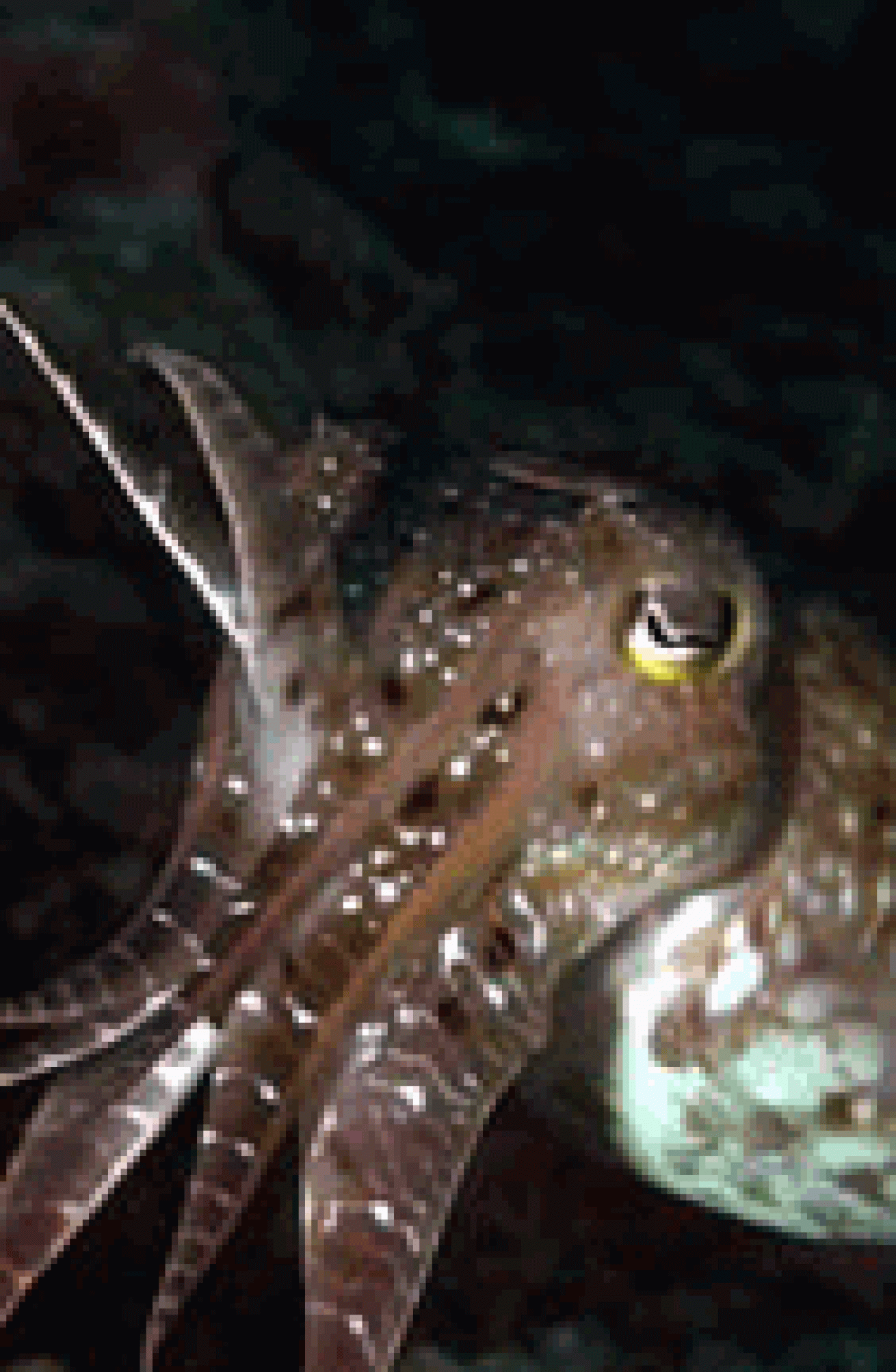
Date: Sunday, June 30, 2002
Location: Kavieng, Papua New Guinea
Today was our last day of diving from the Paradise Sport. We started the day at Anemone Patches, were we again visited the Anemonefish and pair of Leaf Scorpionfish. I photographed an accommodating pair of Fire Dartfish and we were joined by three cooperative Cuttlefish.
After breakfast, I donned scuba gear and returned to the shallows of Mascotte Channel, the site of yesterday's fantastic snorkeling. I was joined by Steve, while Hanna and Alexa snorkeled overhead. Once again, the sun was shining and the reef was beautiful. While I photographed a Yellow Shrimp Goby, Alexa Frink made the find of the day, spotting a Devil Scorpionfish buried in the sand. The surge made photographing the Devil Scorpionfish difficult, but Steve solved the problem by asking Alexa to stand on his back in three feet of water, thereby anchoring him to the bottom for the shot.
We left Mascotte Channel in mid-morning to return to Byron Strait for our final dive of the trip. The current was very, very strong, making the dive very difficult. The sharks were back, including a Gray Whaler that seemed to be taking too much of an interest in me. A large school of Barracuda swam overhead. I ascended into a driving rainstorm at the surface after a short dive.

As the Paradise Sport cruised back towards Kavieng, the crew has planned a shore excursion on a small, deserted isle for a final champagne toast and celebration. The rain finally lets up and we get everyone in their Stephen Frink MFT Photo Tour team shirts and get the group picture. After a bit of socialization and Frisbee-throwing on the beach this group of photo enthusiasts is riveted by one final, amazing sunset. Unfortunately, one of our group slips on an algae covered rock, dinging an elbow, breaking the shoe mount on his strobe, and drowning a Nikon F100. A friend goes to his aid and slips on the same rocks, smashing his lens but gratefully saving his D1X digital camera. Then yet another of our group went to the rescue as well, naturally falls, but gratefully without any cameras in his hand to damage. By then, the rest of us are watching in horrified disbelief but no one is moving towards THOSE rocks, at least not with cameras in hand!
Fortunately no one got seriously hurt, but it is a shame to have had equipment problems now so late in the trip. Better now than at the start though I guess, as no images were lost as a result. Between a flooded RS the first day, a drowned topside strobe, and now the water and impact damage from the "Revenge of the Algae", the group is now calling themselves "Kavieng Survivors". In jest of course, for a good time was had by all. Thanks to the Paradise Sport and her crew for extraordinary service and support of our photo imperative.
Photos captured digitally on Nikon D1X cameras in Seacam housings. Lenses include 17-35 zoom, 14, 16, 60, and 105mm Micro-Nikkor.






